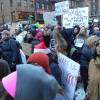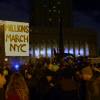Ferguson and Community Trauma: Defining Peace For Ourselves
Feature image via The Guardian
This piece was originally published on 1/12/2005.
George Floyd was murdered on May 25, 2020, and we stand in unequivocal support of the protests and uprisings that have swept the US since that day, and against the unconscionable violence of the police and US state. We can’t continue with business as usual. We will be celebrating Pride as an uprising. This month, Autostraddle is focusing on content related to this struggle, the fight against white supremacy and the fight for Black lives and Black futures. Instead, we’re publishing and re-highlighting work by and for Black queer and trans folks speaking to their experiences living under white supremacy and the carceral state, and work calling white people to material action.
Author’s Note (06/24/20): Five years after having written this article, I find myself living in the so-called US capital. Washington D.C., also happens to be one of the most over-policed cities in the United States with at least 28 different police forces operating in the District. Twenty-eight different forces to criminalize a predominantly Black territory. Twenty-eight different forces of occupation to control a city that must play host to the political machinations of every genocidal Head of State, but strategically withholds tools of political enfranchisement from its residents. In this current moment of Uprising, the Police State has fought tooth and nail to target and staunch any liberatory acts that have translated to “looting,” destruction of property, or so-called violence by violently persecuting and prosecuting (primarily) Black people. These attempts to end the so-called violence is so obviously a tactic to silence the one language that the State listens to because it was successful: people were listening. I share this life update that no one asked for because I realize that when I wrote this article five years ago, I overlooked two things that I would like to name now.
I advocated against speaking around violence, but inadvertently spoke around something else important. It is important to name that while police brutality and State violence target people of color, we have to be intentional about when we say “people of color” and when we say “Black”. In the years since writing this and other pieces, a phrase that addresses this phenomenon has become more popular: “Don’t say people of color when you mean Black.” I am leaving the original use of “people of color” to give readers an opportunity for some critical thinking. As you read this piece, I hope that when you encounter the word “people of color” you will pause and ask yourself, “how might Black people experience this differently than other people of color?” For example, people of color are victim blamed for the violence we experience and for the so-called violence we use to liberate ourselves; but, how might the victim blaming take a different form for Black people? What allowances are other communities of color given that are withheld from Black communities?
The last thing that I originally overlooked but is glaringly obvious to me now is that I did not speak to the violence of the Carceral State. As my political lens has grown and become more explicitly geared towards decarceration, I think a shortcoming of this article was to overlook the way the prison industrial complex often “finalizes” the work of this white supremacist genocidal project. It is a mechanism of social control to dissuade us from using violence for liberation, it disappears people from our communities, and it reframes our own narratives of freedom by encouraging us to adopt and justify punitive practices within our own organizing efforts. In this particular moment of Uprising, the State is using terrorism and conspiracy charges to cage and destroy freedom fighters. It’s not enough to fight for our right on the outside to heal from and use violence when necessary; we must also fight for our communities who are disappeared behind prison walls.
“There’s blood on many hands tonight — those that incited violence on the street under the guise of protests, that tried to tear down what New York City police officers did every day,” the head of the Patrolmen’s Benevolent Association, Patrick Lynch, said after two NYPD police officers died at the hands of gunman Ismaaiyl Brinsley. For police forces across the United States, which exist as emblems of institutionalized violence and white supremacy, the blood of slain officers comes as a surprise. Police officers aren’t supposed to suffer; they are instead promised glory for fulfilling America’s agenda to exterminate and destroy. There truly is blood on many hands tonight and many nights past and future; but, for many of us people of color, we are born in bloodshed and will continue to shed blood for a country that depends on our death for its life.
Violence is a fact of life for far too many marginalized peoples, especially for queer and trans people of color. We speak around violence, like it’s a sob caught in the back of our throats. I want to examine the various manifestations and influences of violence specifically in communities of color. Social forms of violence aggressively prey on our communities, carrying out an orchestrated, intergenerational genocide. Violence also carries with it political impulses, from the violence we face from oppressive systems to the historical uses of violence in various movements. I very much believe that for many communities of color, violence is both a weapon against and a tool to empower us. I don’t want to speak around violence anymore. This is my attempt to overcome an inherited fear of acknowledging the socio-political brutalities our communities face, and to speak about violence.
Community Trauma
Children are more likely than adults to experience and witness violence, placing the roots of our community’s violence in childhood. We like to imagine childhood as an age of innocence and honored humanity, but especially for children of marginalized populations, that innocence is denied to them from the onset of life. In 2011, National Surveys of Children’s Exposure to Violence (NatSCEV) interviewed a group of young people to measure the different types of violence that children experience. The survey determined that in 2011, nearly one-half (41%) of children were physically assaulted within the previous year, and more than half (55%) had been assaulted during their lifetime. The survey also found that children often experienced violence multiple times with 48% of children reporting more than one form of victimization in the past year.
The above statistics do not take into account how race, gender, and sexuality influence the violence that children of color experience, and that police brutality, drug related crimes, and systemic violence perpetuated by the healthcare system, education system, and economy disproportionately influence communities of color. (The NatSCEV study does include a portion about gender in a different excerpt.)
The degradation of the person of color begins psychologically, as children who witness or experience violence often demonstrate symptoms of repetitive traumatic dreams, cognitive confusion, pervasive pessimism, and a “sense of a foreshortened future” (Groves, Betsy McAlister. Children Who See Too Much). The degradation of the person of color begins cognitively, as neurological changes that can increase impulsive and violent behavior lead to “lower cognitive functioning, poor school performance, lack of conflict-resolution skills, limited problem-solving skills, pro-violence attitudes, belief in rigid gender stereotypes and male dominance” (Muscari, M. “How Does Exposure to Violence Affect Children?”).
The degradation of the person of color begins spiritually, with the victim blaming that mainstream society flings at people with a history of trauma. The degradation of the person of color begins intentionally, when a country that has displaced, oppressed, slaughtered, and brutalized so many people of color designs a system to implement the destruction of a individual’s humanity on a community level in the name of white supremacy.
We see violence not only in the crimson of blood spilled far too many times but also in the varying shades of brown on the skins of people of color. To be a person of color in the United States, and in the global narrative, is to be the shadow of violence. Our trauma manifests on a community level, to an extreme that self-perpetuates violence intergenerationally to keep us oppressed. The intergenerational cycle of violence begins as violence breeds trauma. Traumatized children become traumatized adults, and due to structural inequalities that forge barriers between people of color and adequate healthcare that may reduce the harm of said trauma, these traumatized adults are forced to carry the burden of their society-inflicted pain. Trying to overcome a capitalist system that economically disenfranchises people of color, housing inequalities that cage people of color in environmental disadvantaged areas, and a number of other societal hindrances, many of these adults will raise the next generation to the best of their abilities, but these children already inherit the trauma that precedes them. What institutions of white supremacy, like the police force, fail to understand is that if violence is our inheritance, it can also be our birthright. If we can engage in community-level healing to disrupt the power of trauma over our communities, we can turn violence on its head and use it as a tool for our liberation.
Violence as a Strategy
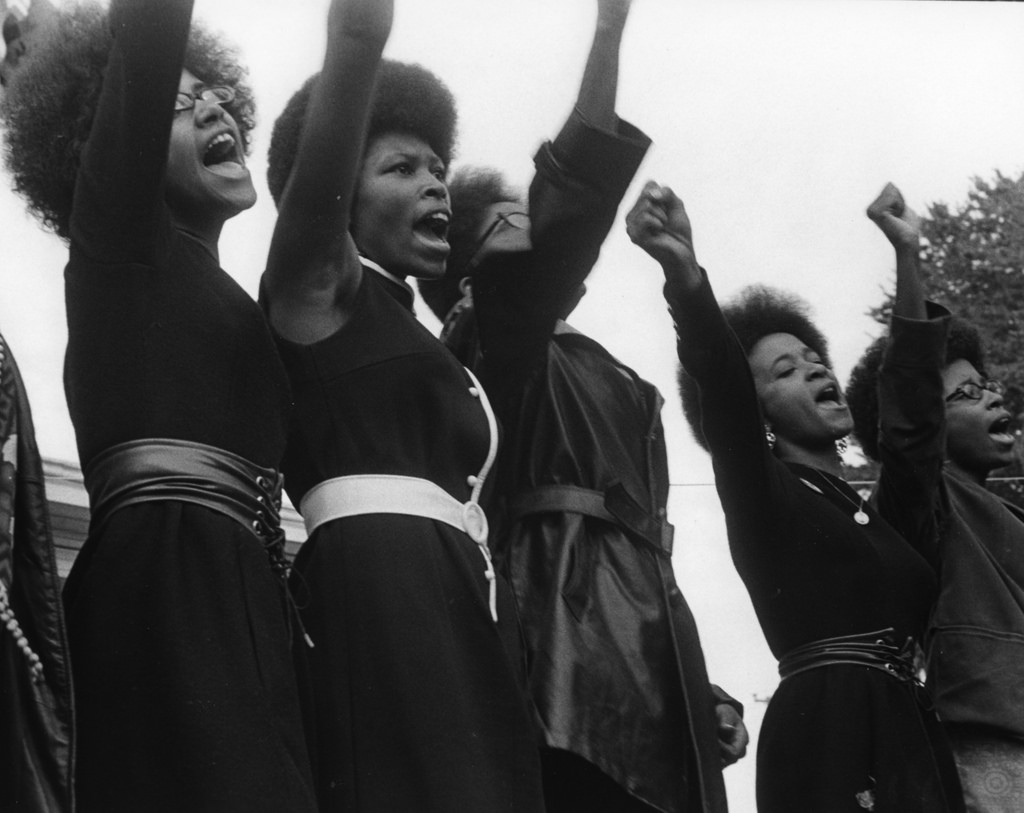
via Golden GatExpress
Women of the Black Panther Party
If I had a dime for every time mainstream media fed the public the most sanitized versions of liberation struggles, I would be able to pay off my student loans in one shot. Hetero-patriarchal white supremacist portrayals of marginalized peoples’ successful efforts for liberation as passive, coded through the language of “non-violence,” is an act of historical violence. It robs communities of their own agency and places the burden of justice on oppressed people’s ability to ask for their humanity just right instead of on the oppressor to recognize the everyone’s humanity. In late November, when a Ferguson grand jury acquitted Darren Wilson in the shooting death of teenage Michael Brown, one of the first things President Obama made sure to emphasize was that angry people of color should be peaceful. Asserting that he has “no sympathy at all for destroying your own communities,” President Obama pointed out:
“There are productive ways of responding and expressing those frustrations, and there are destructive ways of responding,” Obama said. “Burning buildings, torching cars, destroying property, putting people at risk — that’s destructive and there’s no excuse for it. Those are criminal acts. And people should be prosecuted if they engage in criminal acts.”
The rhetoric of peaceful protests that the faux progressive, white supremacist State promotes is a distortion. Peaceful protests, most eagerly invoked in reference to the Civil Rights Era of the 1960s, were a strategy, not a cure-all or a default method for liberation. In fact, even when Civil Rights leaders like Dr. Martin Luther King Jr., or Bayard Rustin championed nonviolence as a tactic, they were actively engaging with violence. The nonviolence of protesters in the 1960s only furthered their cause to the extent that the violence of white supremacists remained present.
Revolutionary organizations and individuals also used violence as a direct strategy in their work. From the Black Panther Party, to the American Indian Movement, to the Stonewall rioters, marginalized people make gains through “violent” means as well as nonviolent methods. The mainstream argument that violence will not achieve liberation is a mechanism for control that seeks to make marginalized people complicit in their own oppression. It is a plea for people of color, women, poor folks, queer people, trans people, disabled people, and anyone who happens to find themselves at the intersection of any or all of those identities to make their emancipation efforts as convenient and comfortable for the oppressor as possible.
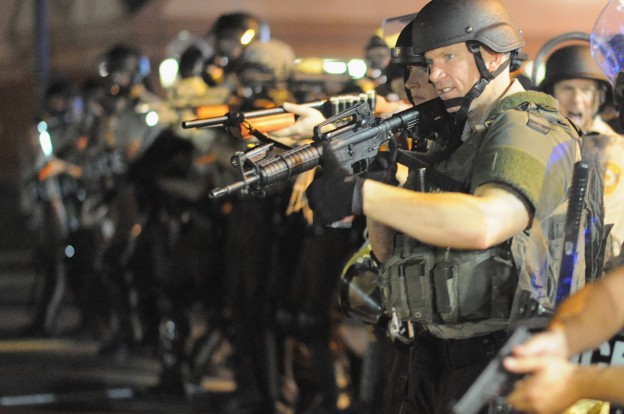
via Here And Now
Pictured above, nonviolent police officers kindly advocating against injustice
Assata Shakur wisely defended that “nobody in the world, nobody in history, has ever gotten their freedom by appealing to the moral sense of the people who were oppressing them.” A murderous State cannot tell us that we must protest “peacefully.” An appropriative State can’t instruct us not to destroy communities that we’ve never been allowed to fully own. In fact, revolutionary philosopher Frantz Fanon believed that only absolute violence could disrupt the white supremacist system of oppression because it undoes the violence created to keep the oppressed obedient and complacent.
This thought piece is not a call to set fire to everything within a 10 mile radius of your computer; however, it is an examination of violence in our queer communities of color, as well as in our white supremacist nation states. America doesn’t have a conscience, and every acquittal of racist cops who continue the genocide America has spent the last few centuries endorsing proves it. America can’t thrive off of violence and death and still define the moral high ground for liberation. So a murderous State can’t tell us queer folks of color, poor queers, disabled queers, and everyone in between that we must protest peacefully in order for us to get justice. Many of our ancestors were violently forced to build this nation, and it is our birthright to tear it down.
Ownership of Violence
Violence features so prominently in many of our communities, and yet it exists as the unacknowledged specter in queer spaces, and particularly in spaces for queer people of color. In a self-preservative gesture, I think we speak around violence in an effort to have some reprieve from it. While it is important for us to forge spaces in our communities that are explicitly nonviolent to give us a chance for collective healing, we must speak loudly about the violences we face and as a result take ownership of them. We must recognize that the majority of us are covered in someone’s blood, if not our own. When we own the violence we face, we can begin to break the shackles of trauma that keeps our communities disenfranchised and oppressed. We can fortify our communities with love and with hope. Moreover, if we own our violence, instead of fearing it because we see how violence has wrecked our families, neighborhoods, and communities, we can use violence as a tool for liberation, when it is necessary.
We are violence (though not necessarily violent) by nature of our marginalization, but we are also so powerful and so empowered. With every “riot” or protest, I see my fellow people of color, QPOC, and even allies breaking chains of oppression. Violence may have created the state of our world, but we have the right to choose and define peace for ourselves. And the peace I speak of, the peace I dream of is not the State’s model for absolute submission, but our aspiration for liberation.
On the Front Lines: Alternative Forms of Protesting Police Violence
featime image via BC Art Life
This piece was originally published on 1/20/2015.
George Floyd was murdered on May 25, 2020, and we stand in unequivocal support of the protests and uprisings that have swept the US since that day, and against the unconscionable violence of the police and US state. We can’t continue with business as usual. We will be celebrating Pride as an uprising. This month, Autostraddle is focusing on content related to this struggle, the fight against white supremacy and the fight for Black lives and Black futures. Instead, we’re publishing and re-highlighting work by and for Black queer and trans folks speaking to their experiences living under white supremacy and the carceral state, and work calling white people to material action.
Here at Autostraddle we’ve done a fair amount of coverage of the recent protests swelling around the issue of police violence and systemic racism. We’ve also covered how queer and trans women of color are often both at the center of violence from the police and prison system, and at the same time on the front lines of the protests to stop it. For people who want to see change, we are full, heavy, and undone by the outpouring of support in the streets. We feel as though, perhaps, we are on the brink of revolution. But many of us haven’t been on the literal front lines. Not for lack of rage or revolutionary spirit, but because our advocacy comes in many forms.
A friend of mine, an arts activist who is a theater-maker and who works a low-paying job serving coffee to wealthy fifth avenue suits, was on her way to work when a protester stopped her and demanded to know why she — a woman of color — was not in the streets demanding justice. Her answer? “I have to pay rent.” A luxury for many protesters is having a warm home to return to at the end of the night, a home for which somebody probably pays rent. Speaking of payment, getting arrested often precludes paying a fine, or bail, or having a friend or family member to call who can come pick you up. What if you are homeless, or estranged from family? What if you have a job that would not be patient if you are late or absent because you spent the evening at Central Bookings? What if you are physically unable to attend a protest because you use a wheelchair or otherwise disabled? What if you just don’t want to chant and march through the streets in the bitter cold?
Friends and family have leadingly asked me, “so did you ever go to the protest?” as though if I hadn’t, I was doing a disservice to our race. I know of other POCs who couldn’t bring themselves to protest because the very weight of the perpetual onslaught of depressing headline after depressing headline left them feeling emotionally weak. But I have found that those same people, wracked with guilt, have contributed in their own ways, sometimes unwittingly. After the first few nights of emotionally charged spontaneous protests broke out in New York, Autostraddle’s very own Gabby Rivera organized a Google hangout session for QTPOC Speakeasy members. We expressed our outrage, our exhaustion, as well the humor that might seem inappropriate to an outsider, but which was so very necessary if we were to have enough stamina to face the day. During the hangout, we came to the realization that what Gabby had done for us was community care. She was affecting change by giving others a place to prepare themselves to affect change. That is valuable. It’s not as visible as attending a march. There were no selfies to prove we had been there. But it had tangible value.
Alternative forms of protest are necessary to make activism accessible. Sometimes, they’re even more effective at creating change than a permitted march. Here at Autostraddle, we have heard from readers far and wide who say that the content on this website has given them a sense of community they couldn’t find elsewhere. I mean, not to toot our own horn but that’s freaking incredible! Where better to convene a mass of rad queers than on the web? Where better to plot the revolution? If you are feeling bummed about not being able to, or not wanting to attend a protest or a die-in, you don’t have to be. There are a myriad of ways you can contribute, and you might already be doing it without knowing.
When petition sites like Change.org started popping up, there was a lot of skepticism surrounding the effectiveness of a petition that was just too easy to sign. Long before any of these phenomena, “Facebook activists” were taking advantage of easy access to hundreds and thousands of people to disseminate information from independent and alternative news sources, to the annoyance of some, but the benefit of many.
Now, the positive effects of cyber activism are becoming clear. Petitions on Change.org and other sites have countless success stories. I first heard about the Michael Brown case from a Change.org email. I know many others who received this tragic news the same way. This was amidst the End Stop-and-Frisk campaign taking off in NYC, and I believe the confluence of these two events have inextricably tied Ferguson to New York, even before the police murder of Eric Garner. Something as simple as signing up for an email listserve brought the Michael Brown case to the doorstep of every American, and helped galvanize a nation. Previously, the memory of Michael Brown would have been reduced to a statistic.
Entire revolutions have been facilitated via Twitter and Facebook. American movements have taken a page from their book, using Twitter to locate protests in real-time without alerting the authorities. Other hashtag movements have given a voice to those usually marginalized. For example, the twitter-facilitated movement, #YouOKSis encourages women, especially women of color to be active bystanders in instances of street harassment, and to share those experiences on twitter. Creating a community where women of color know they can rely on others to check in and prevent potentially violent interactions in the street can offer peace of mind to women whose voices are often drowned out by the patriarchy.
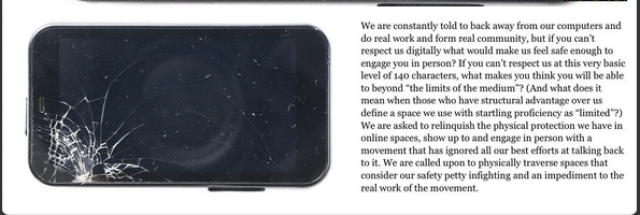
Speaking of creating space, #ThisTweetCalledMyBack recently came to the defense of what has been dubbed “Toxic Twitter.” Toxic Twitter refers to primarily POC women and marginalized communities that have found their voices in the Twitterverse:
We are your unwaged labor in our little corner of the internet that feeds a movement. Hours of teach-ins, hashtags, Twitter chats, video chats and phone calls to create a sustainable narrative and conversation around decolonization and antiblackness. As an online collective of Black, AfroIndigenous, and NDN women, we have created an entire framework with which to understand gender violence and racial hierarchy in a global and U.S. context. In order to do this however, we have had to shake up a few existing narratives…
The response has been sometimes loving, but in most cases we’ve faced nothing but pushback in the form of trolls, stalking. We’ve, at separate turns, been stopped and detained crossing international borders and questioned about our work, been tailed and targeted by police, had our livelihoods threatened with calls to our job, been threatened with rape on Twitter itself, faced triggering PTSD, and trudged the physical burden of all of this abuse. This has all occurred while we see our work take wings and inform an entire movement. A movement that also refuses to make space for us while frequently joining in the naming of us as “Toxic Twitter.” Why do we face barriers at every turn? If you hear many tell it, we are simply lazy women with good internet connections.
In an age where young women often have cell phones with internet access before they have access to healthcare and social services, why are so many so quick to demean the work of digital feminism in the hands of Black women?… When we ask these questions, we uncover that the only people who meet these qualifications of real activism are cis gender, able bodied people — frequently male.
Online activism is controversial, no doubt. “Hacktivism” is often synonymous with the vigilante hacker organization Anonymous, which has achieved many things by threatening to reveal the personal information of their targets. Often these targets are the subjects of high profile controversies, like the Westboro Baptist Church, or members of the KKK. More recently, Iggy Azalea has been the subject of Anonymous’s ire, after she got into a rather sticky (read: racist) twitter argument with Azealia Banks surrounding the issues of cultural appropriation and solidarity with Black people. The group threatened to release leaked sex tape photos and called her a “trashy bitch.” This kind of misogynist and childish behavior begs the question: who deserves privacy? While we all cower in fear of the elusive NSA, we often applaud Anonymous’ threats because they have progressive ends. But is it really progressive to lord over misguided individuals by threatening to distribute pornographic images of them? Vigilantes not associated with Anonymous, but with the same skill-sets have released nude images of famous women, not-so-famous women, and women who have dared to speak out against misogyny or rape culture. Hacking is a powerful weapon, often misused in the wrong hands. But then, what revolutionary tool doesn’t have the capacity to be misused?
Sometimes art can be more engaging and transformative than a rally or march. Sometimes art has the power to affect more minds than a riot. Theatre of the Oppressed (ToO) is a revolutionary form of theater that teaches visual literacy, and gives oppressed people a platform to not only express their grievances, but address them as well. The creator of ToO is Augusto Boal, a Brazilian man who considered this technique a sort of rehearsal for real life. One of the many forms of ToO is a performance called Forum Theatre, in which members of a community act out a play that describes their predicament, with a protagonist, antagonist and supporting characters. The audience is then invited to “intervene” in the action of the play, performing the piece over and over until a solution is developed that can then be acted out in real life. ToO groups in New York City do a version called Legislative Theatre in which actual legislators participate alongside citizens and social justice organizations to develop policies. In May of 2014, Theatre of the Oppressed NYC put together a legislative theatre festival addressing racism and profiling within the criminal justice system, called Can’t Get Right. Spect-actors (as Boal called participatory audience members), were invited to “watch, act and vote” alongside city policy-makers on reforms that would improve quality of life for Black and brown citizens of New York. In no uncertain terms, this is revolutionary: giving people the tools to be the change they wish to see.
I have heard some compare the recent protests to what it felt like to live through the Civil Rights movement. While I can’t personally attest to that, nostalgia for the revolutionary spirit of the Civil Rights era does seem to be in the air. And with it, have come reworked, or brand new protest songs. Remember when Lauryn Hill came out with Black Rage? The AP recently reported on the resurgence of protest songs from the rank and file protesters, poets and songwriters. And then D’Angelo released his album Black Messiah, with a tribute to brothers and sisters in the struggle:
Black Messiah is a hell of a name for an album. It can be easily misunderstood. Many will think it’s about religion. Some will jump to the conclusion that I’m calling myself a Black Messiah. For me, the title is about all of us… It’s about people rising up in Ferguson and in Egypt and in Occupy Wall Street and in every place where a community has had enough and decides to make change happen. It’s not about praising one charismatic leader but celebrating thousands of them.
Hip Hop and Black music have always had a sociopolitical undercurrent, but it does seem that we’re developing a soundtrack for our revolution — and it’s sounding pretty funky.
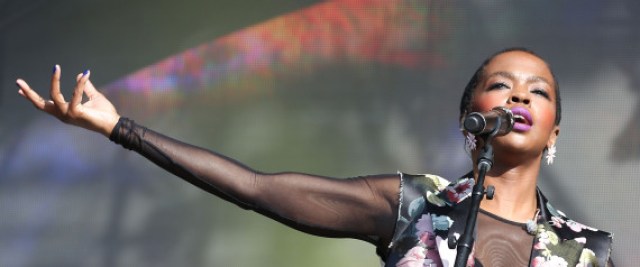
Beyond the web and the stage, there are unlimited ways to contribute our time, energy and money towards a world we would want to raise our kids in. Economic boycotts have been a major part of the anti-police violence movement. Temporarily hindering the economy sends a big message to companies that tend to ignore the plight of the very people they probably employ.
While the alternatives to protest discussed here are by no means all-inclusive, hopefully they’ve inspired you to employ the skills I know you’ve got tucked away in that gorgeous, complicated, infinite brain of yours to do something particular to your interests. If you really don’t know where to begin, Tikkun.org has released a flyer detailing exactly 26 Ways To Be In the Struggle Beyond the Streets. Some of my favorites off the list include providing childcare to protesters, and cooking a pre or post-march meal. Whichever way we choose to participate in this movement, it is important to recognize those who came before us and amplify the voices most often silenced. If we follow those two rules, no form of protest is necessarily more or less valuable than another.
“Out In The Night,” the Story of Four Black Lesbians Convicted for Self Defense, Premieres on PBS and Logo Tonight
In August of 2006, seven black lesbians from New Jersey were hanging out in the West Village of New York City when they were harassed and violently threatened by a man on the street. When they defended themselves, they were arrested and charged with attempted murder and gang assault. Four of the women — Renata Hill, Patreese Johnson, Terrain Dandrige and Venice Brown — plead not-guilty, knowing they were acting in self-defense. They were convicted and given sentences ranging from three to eleven years. Their case became a focal point for activism supporting the women and their case, and protesting the violence, racism, misogyny and homophobia of the legal system that systematically prosecutes women for trying to save their own lives. They became known as the New Jersey Four.
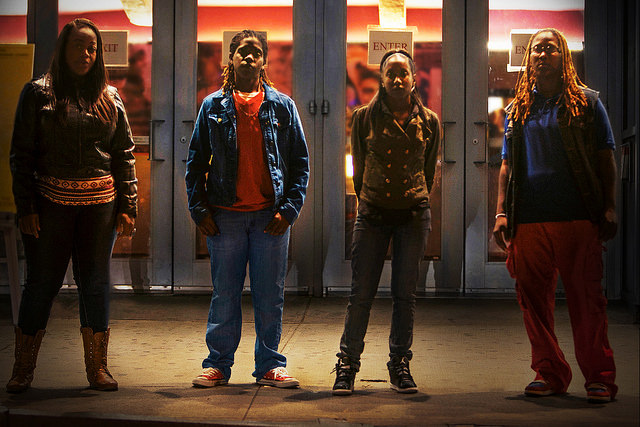
Venice Brown, Terrain Dandrige, Patreese Johnson and Renata Hill via POV
On Monday, June 22nd at 10pm, Out In The Night, a documentary film by blair dorosh-walther, following the New Jersey Four’s case from 2008 to 2013, will be broadcast on Logo and PBS simultaneously. This is the first time it will be aired on TV, and it kicks off PBS’s POV (Point of View) documentary season as well as Logo’s new documentary series, Logo Documentary Films. “This is the first time PBS has ever worked with another network in this way — to simultaneously air a documentary,” said Logo Public Relations and Media Affairs representative Rich Ferraro. “So we’re going to work, as both of these networks, to get this story out there.”
“It’s very rare for a film to be on two different stations, so we’re very excited about reaching a broader audience,” dorosh-walther said.
At 12AM on June 23rd, after the film’s broadcast premiere, it will be available to stream online.
The film, which premiered a year ago at the LA Film Festival and has since been screened over 90 times, has coincided with the Black Lives Matter movement and public outcry over the violence black people face daily across the U.S. Hill and dorosh-walther both spoke to the potential of the film to raise awareness of widespread violence and bias in the court system against black women, black queer people, black gender non-conforming people, and black youth. Hill said, “I want numerous people to be able to connect with the film. I know that our story is the story of so many others, and I want those people to know that they’re not alone and that they do have the right to fight back. The more we verbalize what’s happening to us, maybe the faster we get results. We have the right to be respected just as much as anybody else.”
She also spoke to the connections between her case and other black women who have been arrested and prosecuted for acting in self-defense. “CeCe McDonald’s case is not just CeCe McDonald’s case – that’s my case and so many others, like Marissa Alexander’s. And as we raise awareness about our own documentary, we are given the opportunity to raise awareness about the other situations going on around us.”
dorosh-walther spoke to the significance of the four’s decision to fight back and then plead not-guilty to the charges against them: “I really believe they were this pocket of resistance that night on the street, and again in the courtroom when they pled not guilty. They were facing 25 years, and that’s incredibly difficult thing to do, to plead not guilty. I think that they should be honored and admired for their strength and their courage and their resistance.”
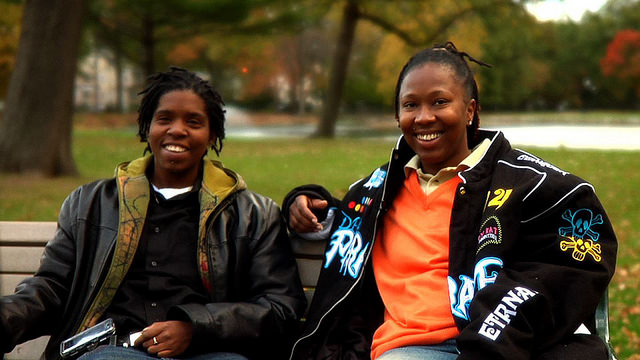
Terrain Dandrige and Renata Hill via POV
Out in the Night is an hour long, and covers a lot of ground, from showing the impact the attack and the case had on the four women and their families, to describing the details of the attack from the women’s perspective. The perspective of the New Jersey Four was sorely lacking from mainstream media’s coverage of the incident. They were portrayed as a “gang” of “killer lesbians,” falsely associating the charges of “gang assault” with actual gang association, and encouraging speculation on their motives based on racist and homophobic stereotypes. Bill O’Reilly took the opportunity to spend several segments of his show claiming that gangs of lesbians were taking over the United States. Several media outlets also used the term “wolf pack” to describe the group of women, drawing on a racialized term generally associated with men to capitalize on racist and homophobic stereotypes, in order to demonize them for acting in self-defense.
dorosh-walther breaks down the mainstream media’s depiction of the case and builds up the narrative the New Jersey Four never got to tell. She walks the viewer through the case and the appeals process, explaining how problems and inaccuracies in the initial trials led to convictions that were ultimately overturned or retried with outcomes of lesser sentences.
The process of making the film started after dorosh-walther had been working on the case for two years as an activist. She was initially hesitant to take on the project because of her position as a white director, but when the appeals process started in 2008 and both media attention and fundraising hit a lull, she decided to visit with the women, their families and their lawyers to see if they were interested in being part of a film. Hill talked about what it was like to meet dorosh-walther, talk about the case on camera and tour with it after it was completed.
“When blair started to get to know us first, so we could get to feel comfortable, that made it easier going in… we formed a bond with one another. At the beginning, we just wanted to get our side of the story out there, so people could get a better understanding of what actually transpired that night, instead of just going off of how the media portrayed us to be.
Having to relive that moment numerous times, speaking about it – it was hard, but I knew at the end of the day it would be worth it because of the outcome. …once it was completed, being on the road and seeing that so many other people were on our side and wanted to listen, that we had the opportunity to reclaim our lives and be seen as human beings – it was amazing. I never saw it being where it is today.”
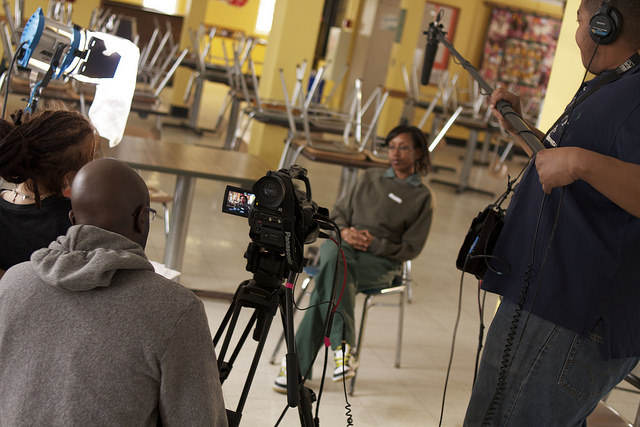
dorosh-walther interviews Johnson in prison via POV
Following the broadcast, there will continue to be screenings of the film at colleges and universities, and an outreach and engagement campaign is in development, aiming to utilize the film to support and sustain work that’s being done on issues related to the film. Hill hopes the film will reach the President. “I think this should be pushed to the White House,” she said. “I want Obama to watch this on his big screen TV. I want him to look at his sisters and his daughters, and think, what else can I do to save women’s lives and lives in the LGBT community?”
Hill described how the film connects the attack on the New Jersey Four to the widespread violence that continues against black Americans: “As we raise awareness about our own documentary, we are given the opportunity to raise awareness about the other situations going on around us, like Trayvon Martin, Eric Garner, Mike Brown,” she said. “It gives this documentary and myself so much more purpose to be able to speak for those who can’t speak for themselves.”
The white supremacist terror attack on the Emmanuel AME Church in Charleston happened hours after I spoke with Hill and dorosh-walther. Out in the Night helps illustrate how, when we think about the murders in Charleston, we need to also be thinking about its wider context within a misogynistic white supremacist society that condones and permits violence against black people, and in particular black women.
dorosh-walther added in an email,
“My immediate response to the devastating attack on Emmanuel AME Church is the way in which the mainstream news is coddling and protecting Dylann Roof… #BlackLivesMatter is not just about caring that Black lives are lost to hate violence, it is the systemic racism that is infected in the mainstream news media and I think anyone not calling this a terrorist attack is helping to perpetuate a more dangerous environment. Just as I believe the articles that were written about the [New Jersey Four] helped created a more dangerous environment for queer youth of color and specifically Black lesbians.”
Out in the Night is a brilliant film that gives us the opportunity to hear from from Hill, from Johnson, from Dandridge and from Brown; and to be inspired by their resistance and survival in the face of violence and injustice.
WATCH THE FILM
Tune in to PBS or Logo at 10pm EST, TONIGHT June 22nd
Stream the film on PBS from June 23rd to July 23rd
Also remember that even if you don’t have cable, your family members, friends, or professors might. If you see them today or talk to them today, tell them this is on. It’s an opportunity for them to see and support queer media on Public Television.
Black Lives Matter Releases Inaugural State Of The Black Union Address, Hosts Twitter Town Hall
On Wednesday, members of the #BlackLivesMatter movement responded to President Obama’s sixth State of the Union address by releasing the first ever State of the Black Union address on blacklivesmatter.com.
In contrast to Obama’s hour-long speech (which addressed issues ranging from Instagram to middle-class economics to the fact that climate change exists, while only lightly grazing the topics of racial justice and police violence), the SOBU was a succinct 1180 words focusing on structural oppression of Black people in the United States. Over a dozen organizations endorsed the statement, including Justice League, Millennial Activists United, Trans Women of Color Collective, Malcolm X Grassroots Movement, and Dream Defenders.
From the SOBU address:
This country owes Black citizens nothing less than full recognition of our human rights. The White House’s current racial justice initiative, My Brother’s Keeper, ignores too many members of our communities. It does not address the inhumane conditions we collectively experience living in a white supremacist system. The issues facing Black women, immigrants, trans and queer people must be included and we demand a full expansion of My Brother’s Keeper to do so.
We demand the same inclusion from our movement.
None of us are free until all of us are free. Our collective efforts have exposed the ugly American traditions of patriarchy, classism, racism, and militarism. These combined have bred a violent culture rife with transphobia, and other forms of illogical hatred.
This corrupt democracy was built on Indigenous genocide and chattel slavery. And continues to thrive on the brutal exploitation of people of color. We recognize that not even a Black President will pronounce our truths. We must continue the task of making America uncomfortable about institutional racism. Together, we will re-imagine what is possible and build a system that is designed for Blackness to thrive.
The address highlighted key statistics on the disparities Black America faces, including:
- The median wealth for single White women is $42,600. For Black women, it’s $5. (Source)
- Blacks and Latinos are about 31 percent of the US population, but 60 percent of the prison population. (Source)
- Since 1976, the United States has executed thirteen times more black defendants with white victims than white defendants with black victims. (Source)
Among the demands listed were an immediate end to police brutality, a public education system that teaches the rich history of Black people, and an inclusive racial justice agenda from the White House.
“2015 is the year of resistance,” the SOBU declared in its powerful conclusion. “We the People, committed to the declaration that Black lives matter, will fight to end the structural oppression that prevents so many from realizing their dreams. We cannot, and will not stop until America recognizes the value of Black life.”
At 8 p.m. EST the same day, a town hall meeting was facilitated by Black Lives Matter national leadership on Twitter hashtag #SOBU, hosted by Hunter Lourdes, co-founder and national director of the Trans Women of Color Collective, and Erica Totten, abolitionist and founder of Live Unchained. The format was a series of questions dropping every 10 minutes, with participants providing their own answers and engaging with each other during the hour-long session.
A sample of some of the responses:
Q1: #SOTU FAILS. What was missing from POTUS Address?
https://twitter.com/SongOfTreasure/status/558067993096486913
A1: mentioned anti semitisn but glossed over anti blackness #SOBU
— TRANS HOODOO FUND (@transhoodoofund) January 22, 2015
https://twitter.com/mxthmsvnshnyrd/status/558068672133357568
Q2: None of us are free until we all GET FREE! How are YOU engaging in collective healing?
https://twitter.com/StylistSunshine/status/558078816149860353
@2LiveUnchained A.2 on Monday we marched. It was beautifully healing & resilient. #SOBU #SOTU pic.twitter.com/NLRSHYPOQ2
— Justice League NYC (@NYjusticeleague) January 22, 2015
https://twitter.com/Awkward_Duck/status/558070071411875841
Q3: 2015 was coined Year Of Resistance and Resilience! What does that look like for the Black Community?
#SOBU A3. Resisting any and all forms of oppression even when it's done internally as a symptom of Stockholm's Syndrome.
— #FixthePolice (@mikebrowncover) January 22, 2015
A3: Prioritizing voices that are often left out of the conversation #SOBU #SOTU
— J Mase III (@JMaseIII) January 22, 2015
https://twitter.com/SoulFreeDreams/status/558073131886469121
Q4: Accountability is a gift. In what ways are YOU actively upholding oppressive spaces?
https://twitter.com/MoJohn8510/status/558074988398669825
https://twitter.com/ThatKittyMcGee/status/558075286223613952
https://twitter.com/RJPate/status/558075929822777344
Q5: Structural oppression manifests in all our lives. In what ways are you committed to dismantling white supremacy?
https://twitter.com/AhmedMoumita/status/558077879905697792
https://twitter.com/FTWSammie/status/558077677291446273
A5. My very existence is dismantling to white supremacy. Black. Woman. Queer. Unapologetic. #SOBU #SOTU
— ashley yates (@brownblaze) January 22, 2015
Q6: Our oppressor will never free us! What is it going to take to gain our collective liberation?
Q6: Unfortunately? Time. Fortunately? Creativity. Which I’ve seen. We need to think about new forms of resistance. #SOBU
— M i c h e l l e (@heymeeshi) January 22, 2015
A6: recognize the interconnectedness of all oppression & that the master's tools will never dismantle the master's house. #SOBU
— blackatlantics (@jananamirah) January 22, 2015
https://twitter.com/FEARLESSnFREE/status/558080904779005953
Following the meeting, Hunter told Autostraddle that she was pleasantly surprised to see only one troll in the discussion. “Having the opportunity to provide a platform for all Black folk to come together on social media and discuss [the state of the union], peel back the layers of structural oppression as well as build community was transformative,” said Hunter. “I feel that any opportunity for folk to live in their truth is an opportunity to celebrate. The Twitter Town Hall provided that opportunity for collective healing, restoration, fellowship and action. We demonstrated that All #BlackLivesMatter.”
For more, check out the State of the Black Union on blacklivesmatter.com, and ongoing discussion on the #SOBU hashtag.
Broken Windows is On Hiatus: Community Interventions We Can Enact Now for Real Justice
feature image via Shutterstock
About a week ago, the NYPD had millions of liberal New Yorkers scratching their heads when they announced a “virtual work stoppage” in apparent protest of Mayor Bill DeBlasio’s alleged lack of support for the Boys in Blue. This came after not only weeks of protests against police terror in New York and across America, but also the senseless murders of two police officers in Bed-Stuy, Brooklyn. Though DeBlasio condemned the murders outright, the police and their union are arguing that his show of support for protesters incited the murders, despite having been committed by a man who had a history of mental illness and shot his own girlfriend in the stomach that very same morning. The police have used this opportunity to literally turn their backs on the mayor as he approached the funerals for the fallen officers. It should be noted that the police union is also currently arbitrating with the city for higher pay.
And so, the police have decided that in addition to the symbolic act of turning their backs on the mayor, they will also stop arresting people for low level crimes (e.g. “quality of life” crimes like open container summonses, public urination, and even parking tickets), resulting in a staggering 66% drop in arrests—and likely an equivalent drop in ticket revenue for the city. The union urged officers not to make arrests unless “absolutely necessary,” leaving most of us wondering what in the hell they were doing before (okay, okay. We knew. It’s just kind of nice to hear them finally admit it). In a bizarre, twilight zone situation, the police have actually practiced civil disobedience and temporarily halted the racist, classist, “broken windows” policing practices that have been the ire of civilian protesters since their introduction. Yeah you heard that right, and it is having benefits for everybody, especially low-income workers and the homeless. Furthermore, the sense of relative serenity in low-income neighborhoods is a welcome change of pace from the constant and looming police presence that has become normalized in these areas.
The incidental benefits of this work stoppage are a bit of a relief, but they are also an opportunity to implement community-based alternatives to policing. Because while we are celebrating the ability to double-park our cars without fear of being ticketed or towed, we are also turning our backs on the millions of incarcerated people who are being brutalized behind closed doors. We are turning our backs on people of color, women and queers who will undoubtedly still bear the brunt of arrests that are being made. Instead, we can forge ahead and create the world we want to live in.
In a the first of a series of video discussions with activists Dean Spade and Reina Gossett, Gossett discusses ways to “prefigure the world you want to live in” through a prison abolitionist lens:
Abolition to me means a number of things. It means preventing harm, intervening on harm, having processes for repairing harm and violence, and also having an aim towards transforming communities, and transforming relationships so that the harm that people have experienced, they’re not re-enacting onto another person.
Abolition means that no one is disposable, no one is expendable. We are not exiling people or punishing people in order to solve our problems. There is a logic in the prison system of policing that kicking someone out of the community and punishing someone is a way to solve people’s problems, but we’re seeing time and time again that that doesn’t work.
Yes, broken windows policing is one of the worst, most racist things to happen to the police and prison system. But even without broken windows, we are left with a prison system that unfairly mishandles people’s lives, especially Black and brown lives. With an eye toward dismantling the current system, there are viable alternatives to involving the police. Many of these focus on low-level offenses, which is a great place to start when looking towards dismantling the entire violent prison system.
In late December, Mike Ludwig of truth-out.org suggested we enter the New Year by resolving not to call the police. For the very same reason that many POCs in poor neighborhoods already choose not to call the cops, Ludwig urged readers to consider how we define safety: “Do we feel unsafe in working-class neighborhoods, or around people with certain styles of dress or colors of skin? What prejudices ground this fear?” He implored readers to think about exactly upon whom we call the cops, and whether they will be treated fairly by the police in a country where police kill one black person every 28 hours. Ludwig makes an important caveat: “Violence is the most serious challenge. If you feel that your safety is threatened, and the best option to avoid being harmed is calling the police, you should do it. Resolving not to call the police is not a rule, just a way to think outside the box. Rules are for the cops, not for us.” Basically, if there is a way to resolve the issue at hand without putting oneself in danger, why not try that option first? As Ludwig points out, many communities are already testing transformative and restorative justice projects that we can use as models during this little policing hiatus.
In Buffalo, NY, local churches, mosques, synagogues and community centers are testing out “peace hubs” in an effort to circumvent police interactions with young offenders. Community conflicts are brought to these peace hubs, and resolved on an interpersonal level. Rod Watson of The Buffalo News thinks it could level the playing field for underprivileged and marginalized youth:
In some ways, it’s a throwback to the days when, if a kid did something wrong, he got chastised twice: first by the neighbor who caught him, then again when he got home. The community wasn’t afraid of its young people and cared enough about them – all of them, not just relatives – to intervene early enough to keep them on track.
If successful, the peace hubs could again give city kids the type of guidance and support suburban kids routinely get to keep them out of the prison pipeline when they do stupid things.
Other organizations like Young New Yorkers aim to both keep young POCs out of prison and engage them on an artistic level that brings their skills back into the community:
Young New Yorkers is a restorative justice, arts program for 16- and 17-year-olds who have open criminal cases. The criminal court gives eligible defendants the option to participate in Young New Yorkers rather than do jail time, community service and have a lifelong criminal record…
A series of six intensive, hands-on workshops prepares the participants to design a public art installation that expresses a positive social message of their choice. Local artists join each workshop and assist the participants in weekly art projects. The weekly artworks and the final installation design are then presented to the public at the Young New Yorkers Finale. The Finale allows the participants to experience themselves as worthy, creative contributors to their communities, rather than as undeserving and irredeemable criminal actors.
Young New Yorkers intervenes after a young person has already interacted with the police, but it is important to have community intervention solutions at every level of the process. The running themes here are empowerment and responsibility to your community, and reducing the harm and violence of mass incarceration. When young people of color are shown that they can make a difference in their communities and in their own lives, prison doesn’t seem like such an inevitable outcome, and commitment to creating justice without police in our communities is a tangible action towards dismantling the prison industrial complex. In addition to fighting for reforms within the prison system, we can keep people out of prison in the first place. We can literally be the change we wish to see in the world.
Burials in the Mist of Dawn
feature image via Reuters
Silence is a signal of unhappiness, and often, of crime. It is the same sort of political instrument as a clatter of weapons or a speech at a rally. Silence is necessary to tyrants and occupiers, who take pains to have their actions accompanied by quiet. Look at how colonialism has fostered silence.
– from The Soccer War, by R. Kapuscinski
I
Alexander Mora Venancio, a student from Raúl Isidro Burgos Rural Teachers College of Ayotzinapa, had been missing since September 26, 2014. He, along with 43 other male students, disappeared after traveling to Iguala, Guerrero, México. The plan was to commandeer a few local buses and drive to the toll booths that connect Acapulco to México City where the students were to shut down the toll booth, both as an act of protest for discriminatory practices by the Mexican government, but also, in Robin Hood fashion, to collect funds from drivers affected by the blockade to use toward their education. The students, or Normalistas as they are known, come from among the poorest families in the state of Guerrero, and Ayotzinapa is the poorest. These rural teachers’ colleges provide just enough education to their students to continue teaching future generations of the families they come from. Aside from using the blockade to collect money, Normalistas also intended to use the buses to attend an event in México City, Distrito Federal (D.F.), to commemorate the Tlatelolco Massacre of 1968, which occurred on October 2, 1968, when the Mexican government arrested and killed students in the Plaza de las Tres Culturas, to squash political opposition just 10 days prior to the opening of the 1968 Summer Olympics, which were to be held in D.F.
The same day that the Normalistas were arriving in Iguala, another event was occurring — a celebration organized by María de los Ángeles Pineda Villa, the wife of Iguala’s mayor, José Luis Abarca Velázquez. Familiar with the politically radical ideas of the Normalistas and afraid they would disrupt her party, either Abarca or his wife ordered the local police to take care of the students from Ayotzinapa, so that her celebration would not be marred. From that point on, there are varying accounts of the story, but it seems that municipal police surrounded the buses and opened fire, killing five. Many escaped, but 44 did not. They were last seen being loaded into vans by police. A day after, one of the 44 missing was discovered, 23-year-old Julio César Mondragón. His eyes gouged out. The flesh of his face stripped clean.
Journalist Alma Guillermoprieto outlined most of the story as it unfolded. There are conflicting reports about what happened next but the official story from the Mexican government is that after local police kidnapped the students, they were handed over to Guerreros Unidos (United Warriors), a gang that the Abarcas might have affiliations with. On October 17, Mexican Attorney General Jesús Murillo Karam announced the arrest of Sidronio Casarrubias Salgado, a leader of Guerreros Unidos, who referred to the Ayotzinapa case as “a casual affair.”
It isn’t until November 7 that three assassins tied to Guerreros Unidos are named as the alleged killers. They outline how they led the students to a dump site and then used gasoline and tires to burn the students the same night they were taken. Some of the students were still alive after they were set on fire.
On November 11, plastic bags full of human remains are recovered near a river in Cocula, Guerrero. A few weeks ago, a bone fragment from the dump site was confirmed by a university in Austria as that of Mora. So far, he is the only one of the missing 43 to be positively identified.
The disappearance of the 43 students has led to international condemnation, the arrest of the Abarcas, mass demonstrations across México, especially in the state of Guerrero and in the capital, México City, as well as the resignation of the Governor of Guerreró, Ángel Aguirre Rivero, and México City Police Chief Jesús Rodríguez Almeida. Federal buildings have been set on fire during some of the demonstrations, but none is more symbolic of México’s boiling political climate than the burning of an effigy of Mexican President Enrique Peña Nieto in the Zócalo, the main plaza of D.F.
But it has not quelled protests. More recently, a news story broke from México’s newspaper Proceso that los federales and Peña Nieto’s administration were either involved or at least knew about the disappearances of the 43 — and that Ayotzinapa is truly a crime of the state.
II
Like most things, my involvement with Ayotzinapa starts with politics, of course, but also, a woman and a bar. I met Meztli Yoalli Rodríguez Aguilera inside the back building of Hole in the Wall, a bar on 26th and Guadalupe Street, across from the University of Texas of Austin campus. Hole in the Wall, established in 1974, is one of the staples of the Drag, as that stretch of Guadalupe is known. I had stopped by for a gin and tonic with a writer friend, who introduced Yoalli to me. A phD student in the Latin American Studies Department at UT, Yoalli had just arrived to Texas not long before we met. It was still August, and still fundamentally hot.
Originally from Puebla, Puebla, México and having completed her undergraduate and masters in Social Anthropology, Yoalli was new to Austin. Every gesture and movement she makes is with fire and intention. Her strong hooded eyes are intense, dark, and deep, similar to a lion. Energy spits off her skin. I knew from the first moments that we exchanged introductions, we would be friends.
After the disappearance of the Ayotzinapa 43, Yoalli immersed herself into organizing vigils and protests with other students and community members in Austin. I turned to Yoalli to understand the significance of Ayotzinapa.
MTO: Why do you think, in a country with a history of disappearances, fosas clandestinas (clandestine graves) and the Juárez femicides, did the Normalistas strike such a chord across México?
YR: I believe that the particularity of the case of the 43 missing students of Ayotzinapa, in a country where there exists other 25,000 disappearances and more than 150,000 murders, resides in the power of collective memory. The 43 missing students, in the memory of many Mexicans, is directly related to the massacre of students of 1968. The massacre of 1968 marked a historic moment in México, as a direct and clear proof of the State’s violence. After 1968, nothing like that has happened; until now. This means that in the last 46 years, this level of violence against dissident voices never occurred again. The criminalization of youth nowadays is evident, the students specially, who are one of the most dissident voices against the current government; they are the ones who are being murdered, disappeared or imprisoned. Ayotzinapa’s case also is really particular due to the origins of the students: all are indigenous and poor, from farmer families. This also reflects the racism and the level of repression and racism in the country.
MTO: What similarities do you see between Ayotzinapa and the protests against police brutality occurring now in the US?
YR: The two movements against police decisions in the US and Ayotzinapa in México are tied together because both are a reflection of the racialized society and “system of justice” we live in. The color and ethnicity are part of how there is institutionalized racism and classism in the judicial systems. Certain bodies (because of color and origins) are marked as criminals and delinquents. It also reflective of the impunity of the state exercising violence against particular populations of the society.
I am tired of the racism, sexism and impunity in the juridical system in México but also in the U.S. I think this a global phenomenon. Unfortunately, we live in a pigmentocracy where color influences your experiences and histories. We have to fight against this system of oppression. I believe collective memory is a way of resistance, we cannot forget what is happening.
And queer movements and indigenous movements are involved in every sense. In México, for example, queer collectives such as Bloque Rosa and Feminist collectives stage protests and write about the violence in México; and also, they march as a queer collective, where they particularized the violence perpetrated against queer people, trans, women, etc. In this sense, they are also denouncing the sexism in the Mexican State (femicides), but also in the “left”, which also tend to criticise the system but still use machista language. Indigenous movements such as the Zapatistas, are also asking for justice for the students, but also a lot of other movements as well, considering that the students were me’phaas and na’savis (indigenous groups from Guerrero).
I believe that there won’t be justice initiated by the State. It is because of the protests, the movements, injustice and the search for dignity that we have hope and people are fighting for justice. Justice will come, but it will come from below, from the organized people, from the parents, from the students, from our society.
III
The philosophy of collective memory was further discussed by French sociologist Maurice Halbwachs in 1950, in his book La Memoire Collective, published after his death in 1945. He explored the meaning of collective memory as shared information between groups of people typically involving a traumatic event. In Central and Latin America, collective memory is as much a method of survival as it is part of history. Uruguayan journalist and poet Eduardo Galeano spoke of it, saying, “Our collective memory has been mutilated by the controllers of the world, who day after day, also mutilate our present reality.” He might as well have been referring to Ayotzinapa.
I read each update about Ayotzinapa and think about riding a public bus in Juárez, years and years ago. The school bus, gutted inside and painted a dull brown outside, cost me almost nothing to take me from one part of inner Ciudad Juárez back to the international bridge linked to El Paso. While it bounced and took sharp turns, I stared out the window at the city’s landscape, knowing that the bus I sat in resembles the same type of bus that transports maquiladoras to and from the factories. It is the same type of bus involved in their disappearances. For all we know, it is the same type of bus that dumps their bodies in the Juárez Valley. I think about the missing women.
In October, I attended a vigil in Austin for the disappeared 43 Normalistas, and I sat far away from the crowd, from their wreath of candles, from their hum of voices. I sat underneath an old gnarled tree. I thought about a Saturday night in April of 2013. I thought about the 47th hour of a 72 hour trip to México. We had been in Ciudad Acuña all day, which shares the border with Del Rio, Texas. I thought about that night, lining up, single file, so I could crowd into a white van and be driven back to the US Border Patrol Station across the Bridge. I thought about being a US citizen being deported out of México and banned from returning for up to a year. With a record number of immigrant deportations committed by the US government, I couldn’t exactly fault the otherwise stone-faced Mexican guards for smirking at the irony of our deportations as we were handed back our US passports. I was last in line, and as we moved forward, the head of Mexican Immigration, a guy with a faux hawk named Sergio, put his hand out, and stopped me.
“You stay,” he had said.
I hadn’t been afraid. Not any of the nine hours we just spent detained in the small fucking office of Mexican Immigration. How could I have been? Compared to the way the US treats immigrants and detainees, we were on a fucking picnic. We had access to the US consulate, to our cell phones, to the snacks we brought along with us. Several of us even had smoke breaks. We sat in a cramped cold office, and we could see our comrades from the Comite Fronterizo de Obreras across the hallway, through the square window with bars. They had not left our side. But now it was 11:30 pm. Our driver and a few others who were not detained had gone and gathered all of our belongings from the Hotel del Prado close to the Plaza. They had driven back across the border already and were waiting for us. But suddenly, I swallowed the panic that swelled up inside. My mother was a Mexican immigrant. I was being recognized as a Mexican citizen. And being Queer usually makes me acutely aware of the space I inhabit. I had heard enough stories about the way Mexican citizens could be treated. And the border is a special kind of purgatory. Rules do not matter much.
“But why?” I asked. “I’m a US citizen too. Just deport me. With the others.”
“No,” he continued. He didn’t even look up from the clipboard. “You are a Mexican citizen. There is a different process.”
“My mom has been a US citizen for almost 10 years.”
“I’ll be back and we will fill out your paperwork and then you can go,” he said.
So I sat alone in the darkly lit back office of Mexican Immigration, untying and retying my red handkerchief around my neck. The laces of my work boots were loose, and I rested my elbows on my knees, bowing my head, hands in my salty hair, trying not to think about what being in a immigrant detention center in Saltillo, México, would look like. Saltillo was about an hour’s drive from where I waited. This was Ciudad Acuna, the Mexican border town across from Del Rio, Texas, where my father’s family was born and where he grew up. Ciudad Acuña was also the town where my great-grandfather was murdered in 1930. He was stabbed in an alleyway for fucking another man’s wife by the wife’s husband. My grandmother barely remembered him.
I could see the bridge to Del Rio, with lights that flickered like UFO’s. I could see the quiet town I spent many summers of my youth, just a mile away, splashing in the brown water underneath the railroad tracks with my distant cousins — the Andrade part of the family. My father’s kin.
I could also see the four guards in their brown uniforms standing watch over me in the other room as I waited for the return of Sergio, the guy who would be able to keep me or let me go. And at that moment, part of me almost hated being Mexican. My black eyes that an ex-girlfriend described as being full of energy and desire and the stormy black hair that stood up and stuck out and never sat down, sort of like lightning. A symbol of utter resistance to any attempt I made at combing it, the least imperial part of my whole body. My mother, a native of Chihuahua, was the reason I was not deported. It was the reason I would not face a year long ban from reentering the country. It was also the reason I was alone and waiting in the room while everyone else was transported back to Del Rio, to US authorities. I waited to find out if I would be processed and released back into Ciudad Acuña, as I had been assured.
The troubling concept of impunity and collusion crept into my mind as I remained inside the office. I didn’t even know if anyone from the Comite Fronterizo de Obreras in México remained outside. If I would be let go into the dark night of a Mexican border town I didn’t know very well.
Impunity does not believe in right and wrong; impunity believes in its power to operate without redress. Power is the keyword. While I had absolutely none in this situation, I reflected on the power of our friends in the CFO. Our subsequent arrest and detainment by Mexican authorities was purely politically motivated, as an attempt not to frighten visiting US citizens, but to intimidate and harass the organizers of the CFO. Because the work these women do as labor organizers challenges structures of power and money that do not desire to give up their power or their money. The CFO regularly faces danger worse than the small inconvenience faced by our delegation. Add to that, the violent power struggle between rival drug cartels enveloping México, and the historically epic corruption of police and government officials… and it’s clear why a worker’s rights group in a border town could be so threatening.
When Mexican authorities returned after midnight, I was asked to sign a document certifying that my mother, a Mexican citizen, granted me Mexican citizenship through bloodline, and thereby insured my release. I was not deported. A guard escorted me out of the building, into the deserted street. I walked out into the night, wondering how to get in contact with my group, how to return to Del Rio, how I didn’t have a phone with me… across the parking lot waited about 15 people from the CFO. They had waited with us throughout the 9 hours of our detainment, and were still waiting on me. And I thought of a saying my ex-girlfriend, a labor organizer and workers’ rights advocate, used often when referring to people united in love and struggle: this is what solidarity looks like.
But unlike the missing 43, I was going home. And it’s what I store in my memory each time I read an article or update about the disappeared. I am home. They are not.
IV
Each uncovered element in the forced disappearance of the Ayotzinapa 43 relates to some aspect of México’s memory of other disappearances, of police impunity, of corruption at the highest levels, and violence perpetrated and sanctioned by the state. From the massacre of 1968 to the unexplained murders and dumping of the bodies of maquiladoras to the murders of immigration activists in Southern México, exists a pool of bloody memories from which Mexicans can choose from.
And I am watching impunity seep its way into the vocabulary of us here in the US too. The increased militarization of US police forces and a culture of impunity have contributed to the deaths of Michael Brown and Eric Garner, just to name a recent few (the violence leveled against black lives in the US is genocide) and lack of indictments for the police officers involved in their murders. I watch it happen here in my home of Austin, where a group of community members called the People’s Task Force pushes for justice for a similar scenario. In summer of 2013, an Austin Police Department detective named Charles Kleinart chased down and shot and killed Larry Jackson, Jr., a young black man, in the back of his neck, in a tunnel underneath a bridge, in the normally quiet park known as Shoal Creek. And for what? Because Jackson happened to be a black man who showed up at a bank that had closed for a robbery earlier in the day?
In a recent post by two members of Witness for Peace, Julia Duranti and Maggie Evans, write about the connections between Plan Colombia and the Mérida Initiative (aka Plan México), both of which are spearheaded by US interest in resources that Colombia and México have to offer.
“Presidents Bush and Uribe found a willing ally for the Wars on Drugs and Terror in right-wing Mexican President Felipe Calderoón, elected in 2006 after Mexican drug cartels had risen to prominence. Shortly thereafter, the Mérida Initiative — also known as Plan México — was approved to “fight organized crime and associated violence.” Since that time, nearly $3 billion in U.S. military aid to México have contributed to the massive militarization of the country: Blackhawk helicopters (at $20 million apiece), thousands of U.S. weapons, extensive training of police and military, increased surveillance of the border and ports, and even U.S. Marshals dressing as Mexican marines to carry out special operations on Mexican soil. The toll on México has been devastating: more than 100,000 dead and more than 26,000 disappeared since 2006.”
The implication is clear. Like Colombia, the displaced and the missing and the mass graves in México did not happen overnight. And they are not isolated events. Francis Goldman of the New Yorker has written a series of pieces chronicling different aspects of Ayotzinapa, from their kidnapping and tying it back to Infrarrealistas, a literary movement that involves Chilean writer Roberto Bolaño.
“In the early nineteen-seventies, [Bolaño] led a group of poets who believed that life in México and in the rest of Latin America was so violent and absurd that poets needed to subvert reality and realism — as well as élitist literary hierarchies — even more than the surrealists had. That attitude has been very much in the air since the Ayotzinapa incident. Indeed, in Reforma earlier this week, the anthropologist and writer Roger Bartra, who is relatively conservative among México’s most prominent public intellectuals, christened “the heterogeneous and radical protest movement that has unleashed massive marches in México City” as “the infrarrealista left.” He chose that name, he writes, “not pejoratively,” but “because this left seems to flow beneath political realities, carving tunnels to topple the government and undermining the cement of a system it considers corrupt and repressive,” just as, he writes, Bolaño and his compatriots sought to “subvert a literary order they considered oppressive.”
V
In Spanish, there is a phrase, desde abajo which translates as “from below.” The disappeared students are not just memories or fosas clandestinas (clandestine graves). They are part of a culture, part of a sequence of pulverizing attempts to silence los desde abajo. So this is where we are. Witnessing los desde abajo push back. Not just in México, but in the mass demonstrations across the US against police brutality and the war against black lives, and the global displays of solidarity for Palestine and other oppressive regimes.
Galeano, in the same interview about collective memory, also says, ‘The dominant culture of the world teaches us that The Other is a threat, that our fellow human beings are a danger. We will all continue to be exiles in one form or another as long as we continue to accept the paradigm that the world is a racetrack or battlefield. I believe that we can be compatriots of many different kinds of people, even though they are born far from our own lands and in other places and in other times.”
Perhaps it is time for that paradigm to shift.
To remember the past.
To change the present.
To rewrite our future.
From Ferguson to Ayotzinapa to Palestine.
To every crack in the earth.
25 Women Who Shook Things Up in 2014
Women. They’re so great! They do so many fucking awesome things! And so often, end-of-the-year recap lists will gloss over their accomplishments or contributions. I say f*ck that, real hard. So here’s my own list of 25 women who shook things up in 2014 – be it in politics, pop culture, or our hearts. (In alphabetical order, because ranking women is tired.)
Alicia Garza, Patrisse Cullors, and Opal Tometi
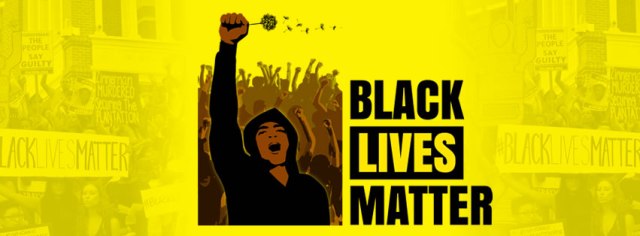
When Twitter exploded with dialogues about racism, police brutality, and the widespread killing of unarmed black men by law enforcement officers, they were united by one trending topic: the #BlackLivesMatter hashtag, which has become its own movement and a catch-all for organizing around these issues and posting updates on similar stories from around the world. It’s also a call to action, a defiant spit in the face to a culture that devalues the lives of people of color, and a rallying cry.
And it was invented by three black queer women.
Garza told the story of how she and her sisters, Cullors and Tometi, came together to launch the digital revolution (and now, an offline organizing structure) after the death of Trayvon Martin – and how, since its remergence after the death of Mike Brown, it has been stolen and co-opted, at the Feminist Wire:
Black Lives Matter is an ideological and political intervention in a world where Black lives are systematically and intentionally targeted for demise. It is an affirmation of Black folks’ contributions to this society, our humanity, and our resilience in the face of deadly oppression.
We were humbled when cultural workers, artists, designers and techies offered their labor and love to expand #BlackLivesMatter beyond a social media hashtag. Opal, Patrisse, and I created the infrastructure for this movement project—moving the hashtag from social media to the streets. Our team grew through a very successful Black Lives Matter ride, led and designed by Patrisse Cullors and Darnell L. Moore, organized to support the movement that is growing in St. Louis, MO, after 18-year old Mike Brown was killed at the hands of Ferguson Police Officer Darren Wilson. We’ve hosted national conference calls focused on issues of critical importance to Black people working hard for the liberation of our people. We’ve connected people across the country working to end the various forms of injustice impacting our people. We’ve created space for the celebration and humanization of Black lives.
Beyoncé
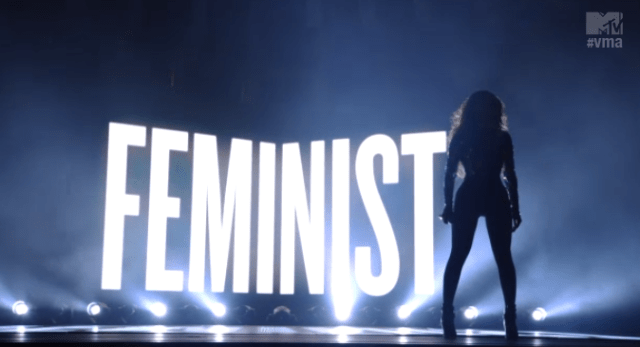
Another year, another surprise album, another round of empowering feminist antics, another year I’m addicted to listening to “Drunk in Love.” Here’s to a brighter and more Bey-filled future. Also, remember when she made us queer couples some matching underthings?
Cheryl Strayed
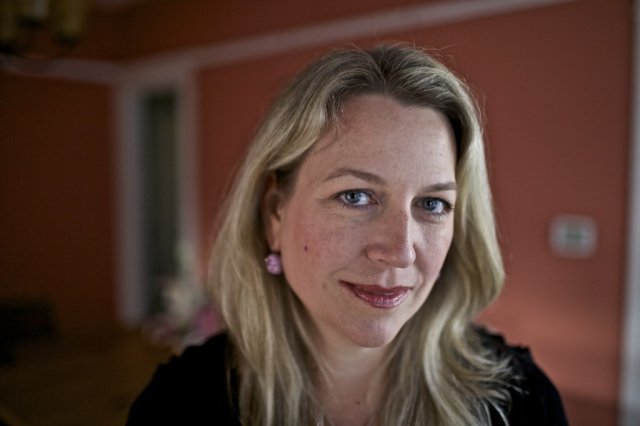
When Wild became a movie and the “Dear Sugar” column got a podcast this year, everyone’s life and ability to be deeply moved or feel less alone in the world grew exponentially. Also, Cheryl Strayed shared Riese’s deeply moving essay about her dead dad on Facebook this year and pretty much everyone on the team exploded. I’m pouring one out for Cheryl Strayed at midnight for breaking the trope of only men taking journeys in literature, being played by Reese Witherspoon, and also being generally amazing. Join me.
Elizabeth Warren
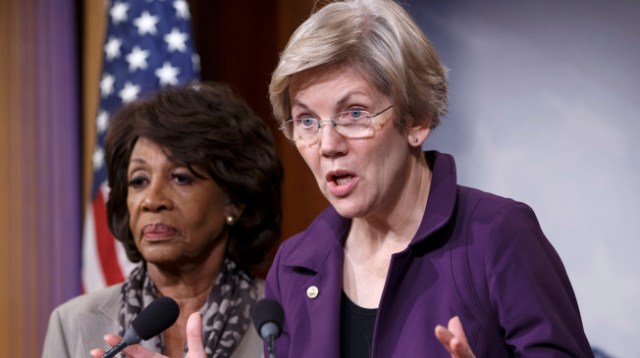
Senator Elizabeth Warren has never been one to back down. In A Fighting Chance, her book released this year, she told a story about a meeting she had with President Obama’s Chief Economic Advisor, Larry Summers, in 2009. Warren had come out swinging, as she is known to do, against the government’s response to the economic crisis. And, as she often finds herself, she spoke to him when she was in conflict with her own party.
Larry leaned back in his chair and offered me some advice. … He teed it up this way: I had a choice. I could be an insider or I could be an outsider. Outsiders can say whatever they want. But people on the inside don’t listen to them. Insiders, however, get lots of access and a chance to push their ideas. People — powerful people — listen to what they have to say. But insiders also understand one unbreakable rule. They don’t criticize other insiders.
I had been warned.
Warren has never backed down, and she’s become known as a populist hero for decrying policies from both sides of the aisle that attack the middle and lower classes in America. Recently, she gained even more notoriety for a pointed speech on the floor condemning the now-passed spending bill package, in which Wall Street got first priority and women’s rights and human rights got the shaft:
“Mr. President, Democrats don’t like Wall Street bailouts,” Warren said. “Republicans don’t like Wall Street bailouts. The American people are disgusted by Wall Street bailouts. And yet here we are five years after Dodd-Frank with Congress on the verge of ramming through a provision that would do nothing for the middle class, do nothing for community banks, do nothing but raise the risk that taxpayers will have to bail out the biggest banks once again…
“You know, there is a lot of talk lately about how Dodd-Frank isn’t perfect. There is a lot of talk coming from CitiGroup about how Dodd-Frank isn’t perfect,” Warren continued. “So let me say this to anyone listening at Citi —I agree with you. Dodd-Frank isn’t perfect. It should have broken you into pieces. If this Congress is going to open up Dodd-Frank in the months ahead then let’s open it up to get tougher, not to create more bailout opportunities.”
Ellen Page

It was the coming out heard ’round the world, and especially around the Internet. It was also the moment where all of our dirtiest dreams became a little more possible. For that, Ellen Page deserves everything.
Emma Sulkowicz
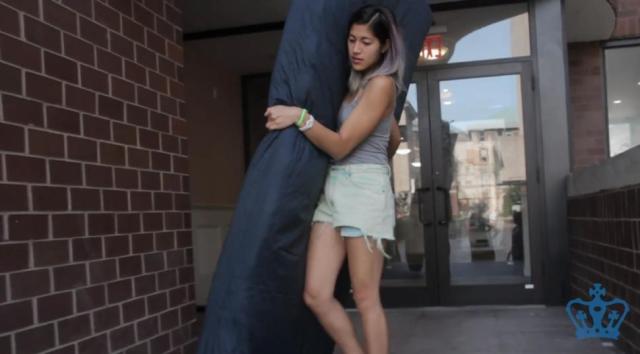
The movement to end campus sexual assault has been gaining momentum for years, but no act of resistance against institutions of higher education that fail survivors captured America’s interest quite like “Carry That Weight,” Columbia University art student and survivor Emma Sulkowicz’s performance piece. As part of her final project in the program, Sulcowicz carried a mattress everywhere she went on campus in order to raise awareness and provoke dialogue around the 1 in 5 women there and at colleges around the nation who will survive sexual assault or rape while they’re pursuing higher education.
The piece ultimately launched a national day of action in which activists around the country carried mattresses or pillowcases to school, work, or the local coffee shop with them emblazoned with messages of support for survivors.
Erica Garner, Lesley McSpadden, Maria Hamilton, Samaria Rice, Sylvia Palmer, et al.
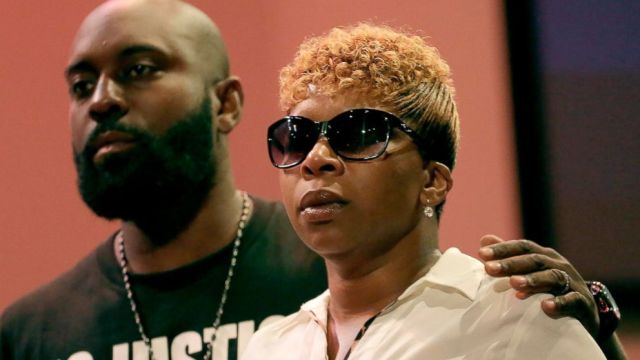
The women who now live without their fathers and sons due to police brutality have banded together across the nation to launch a movement for justice. And together, they are unstoppable.
Lesley McSpadden, mother to unarmed black teen Mike Brown from Ferguson, Missouri, has been supportive of protests nationwide in her son’s name and is pushing for the Mike Brown Law, which would mandate that all police wear body cameras in the United States. Maria Hamilton, whose son Dontre Hamilton was gunned down by a now-fired Chicago police officer while running away in fear, has not stopped fighting for justice for him and all victims of a racist and violent police state. Sylvia Palmer, mother to Akai Gurley – who was shot on sight by a patrolling officer in his public housing unit while walking up the stairs – has voiced support for activists on the ground while pushing for better leadership in the movement to end lethal police force and racist policing. Erica Garner, whose father Eric Garner was killed by police in Staten Island after being held in an illegal chokehold (despite repeating, multiple times, that he couldn’t breathe), has consistently participated in die-ins and marches in the area, sometimes even lying in the spot on the sidewalk where her father died. Samaria Rice, mother to the 12-year old boy, Tamir Rice, who was shot within seconds by Cleveland police for wielding a toy gun at a park, joined the families of Garner, Brown, Trayvon Martin, and John Crawford III in Washington, DC to demand federal action to end excessive force in policing and its disproportionate impact on the black community.
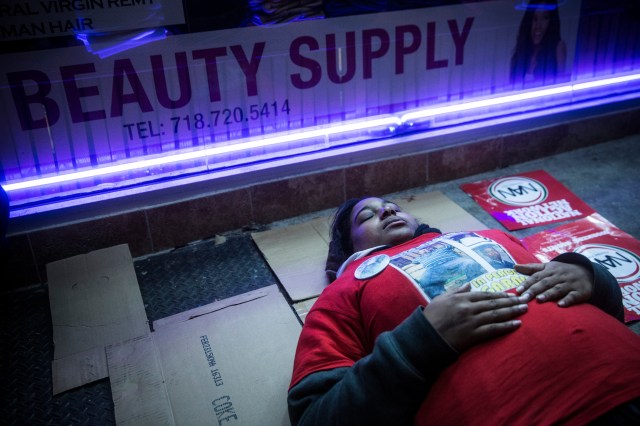
Since Mike Brown’s death, one black person has been murdered by police every single week. That’s why the fight isn’t over, and it’s why these women aren’t backing down.
Issa Rae
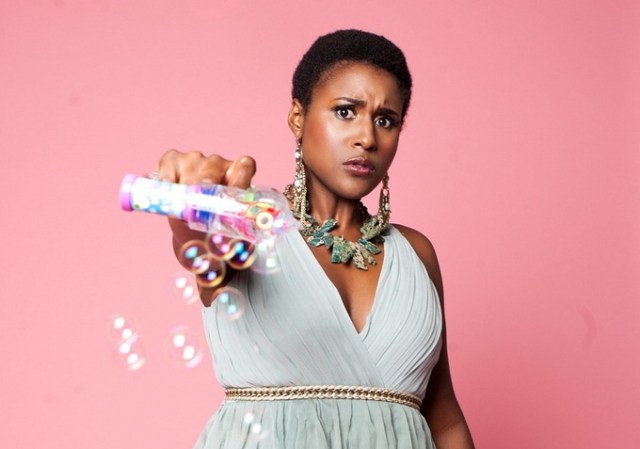
Remember that time one spectacular human being launched ColorCreative.TV and gave Brittani Nichols a platform to do her thing and turn former Autostraddle webseries “Words With Girls” into a bonafide show on the small screen? Yeah, that was Issa Rae of “The Misadventures of Awkward Black Girl” and that sh*t all went down this year. Did you watch the WWG trailer yet, PS? Do it before midnight and you won’t turn into a pumpkin!
Janet Mock

Janet Mock truly outdid herself this year. In between publishing Redefining Realness and launching its corresponding social media movement, taking number-one douchebag Piers Morgan to hell and back, and redefining trans activism through only sheer glamour, she landed herself on the Root 100 and the Trans 100, asked us what it’s like to be cis, and encouraged our love for the words of women of color. Also, she spoke words to us right here on Autostraddle dot com in January! Basically, she’s everything and I’m completely okay with it.
Jacqueline Woodson
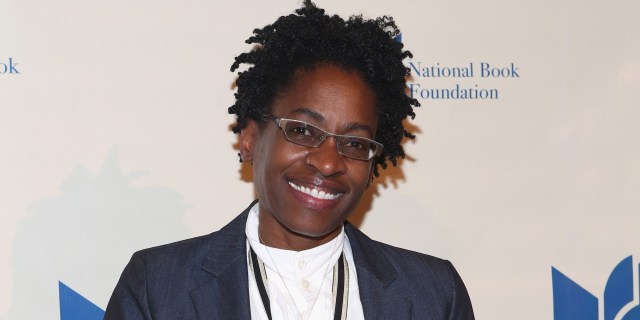
Author Jacqueline Woodson should have spent her night at the National Book Awards this November celebrating her victory in the Young People’s Literature category for her book Brown Girl Dreaming. Instead, total prick Lemony Snicket made a racist watermelon joke about her on stage and basically made everyone there uncomfortable and highly aware of what a series of unfortunate events actually looks like.
Luckily, she took him down. And with her words, no less:
I would have written “Brown Girl Dreaming” if no one had ever wanted to buy it, if it went nowhere but inside a desk drawer that my own children pulled out one day to find a tool for survival, a symbol of how strong we are and how much we’ve come through. Their great-great-great-grandfather fought in the Civil War. Their great-grandfather, Hope, and great-grandmother, Grace, raised one of the few black families in Nelsonville, Ohio, and saw five children through college. Their grandmother’s school in Greenville, Sterling High, was set on fire and burned to the ground.
To know that we African-Americans came here enslaved to work until we died but didn’t die, and instead grew up to become doctors and teachers, architects and presidents — how can these children not carry this history with them for those many moments when someone will attempt to make light of it, or want them to forget the depth and amazingness of their journey?
How could I come from such a past and not know that I am on a mission, too?
This mission is what’s been passed down to me — to write stories that have been historically absent in this country’s body of literature, to create mirrors for the people who so rarely see themselves inside contemporary fiction, and windows for those who think we are no more than the stereotypes they’re so afraid of. To give young people — and all people — a sense of this country’s brilliant and brutal history, so that no one ever thinks they can walk onto a stage one evening and laugh at another’s too often painful past.
Jessica Williams
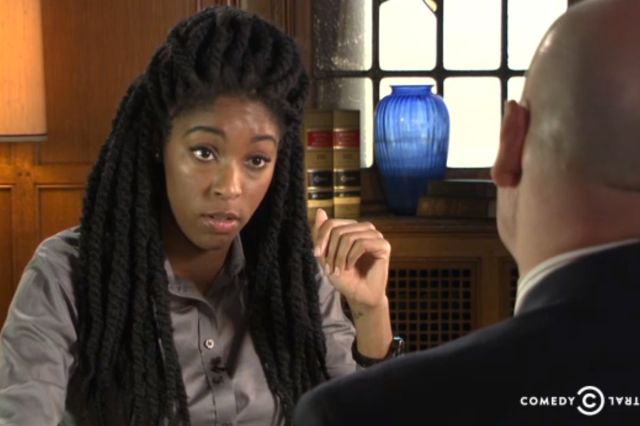
It was a really important year for conversations around street harassment – specifically, about racism in the movement to end catcalling and about ending a culture in which women and queer people are inundated with invasive and unwelcome accostment on the street every day. But one conversation nobody needs to have or really listen to or even acknowledge exists is the one in which men try as hard as their feeble minds will let them to justify a society in which women’s bodies are objects apparently put here for them to yell creepy and gross things at without our permission! Luckily, Jessica Williams from The Daily Show swooped in and shut that entire motherfucking mess down. Boom. Clap. The sound of patriarchy slowly, slowly dying.
Jill Soloway

Jill Soloway produced this show “Transparent” about a trans woman and her family that had hella queer characters, has a badass trans lady writer in the staff room, and motivated Rachel to recap something for this website. ‘Nuff said.
Kate McKinnon
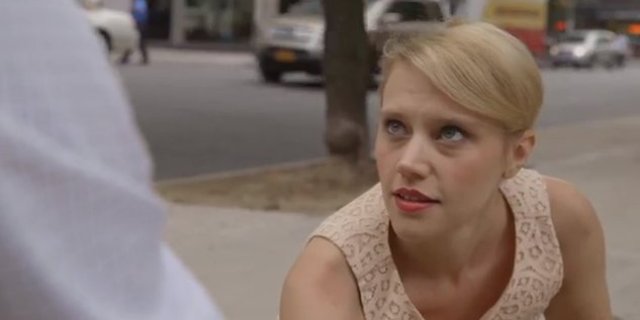
We’ve loved super-funny and super-gay comedian Kate McKinnon here at Autostraddle for a long, long time – so imagine our excitement when she nabbed an American Comedy Award and appeared in totally great totally not-about-a-dude movie Life Partners this year! Plus, she earned an Emmy nod for her amazing work over the last few years on “Saturday Night Live,” which might give me a reason to start watching it again. All in all, it sounds like it’s been McKinnon’s year to shine on.
Kristin Russo and Dannielle Owens-Reid
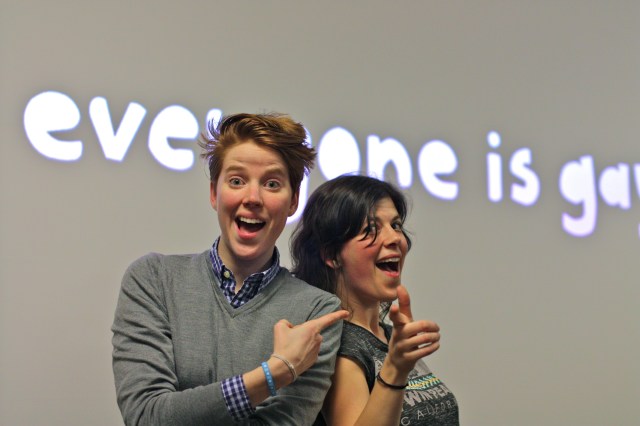
First came the book that Maddie read with her amazing family members (This Is A Book for Parents of Gay Kids), then came the hilarious video tour and also the videos for those parents, then came the collaborative ‘zine project with this great place called Autostraddle that, rumors have it, is also a unicorn factory. One thing is for sure: Kristin Russo and Dannielle Owens-Reid of Everyone Is Gay put a lot of amazing shit into the world this year, and I can’t wait to see what’s next.
Laura Jane Grace
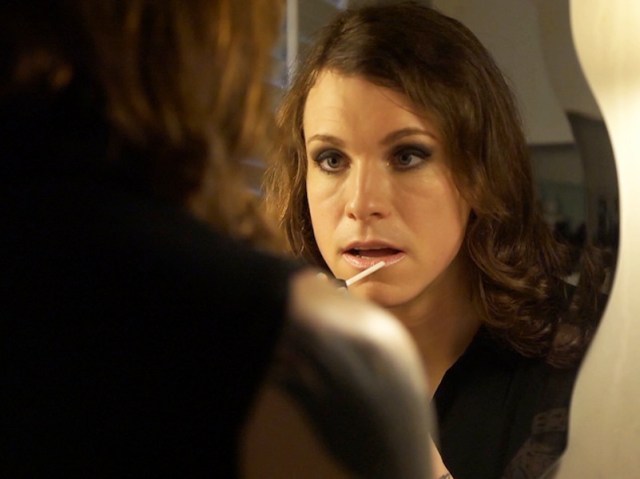
When Against Me! frontwoman Laura Jane Grace came out in 2012 as transgender, we were excited to see where it took her career and the punk band so close to our angsty hearts. As it turns out, there was nowhere to go for the rock-n-roll icon than up. This year, Against Me’s new album debuted higher on the Billboard charts than any of their previous work, and Grace also filmed a reality show for AOL. The good news out of 2014 is that we’re gonna be seeing a lot of Laura Jane Grace for years to come, and that can never be a bad thing.
Laverne Cox
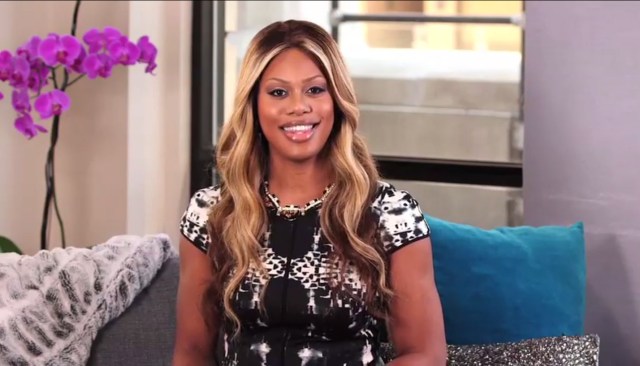
In 2014, Laverne Cox got a book deal, deeply moved us when it came to the topic of the revolutionary act of loving trans women, won a GLAAD award, landed the cover of TIME and also the cover of The Advocate, became the first-ever trans Emmy Award nominee, taught Katie Couric a thing or two, and used her power for good to shine the light on trans youth.
I’m guessing the reason Beyoncé gave Cox a Christmas gift is because she realized exactly which girl is truly running the world.
May-Britt Moser
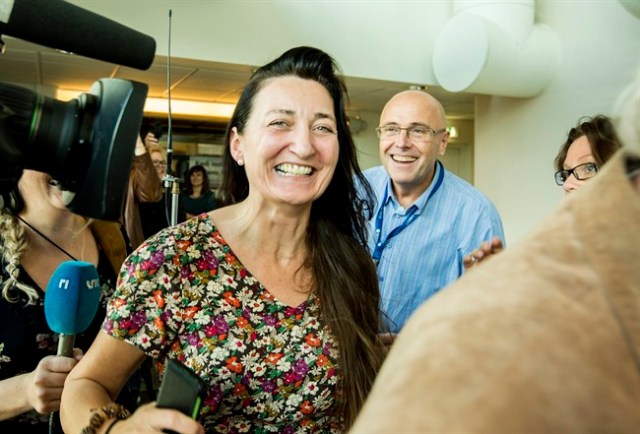
Remember that time May-Britt Moser, psychologist and neuroscientist, won the Nobel Prize for figuring out the cells that make up the brain’s positioning system? I’m worried not enough of us do.
Mo’ne Davis
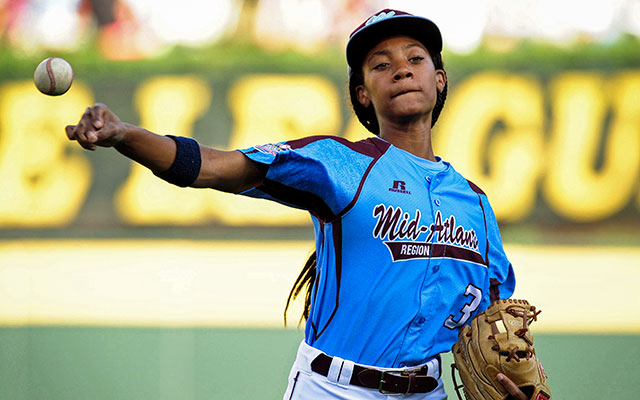
Mere teenager Mo’ne Davis, who was the first girl to throw a shutout in Little League World Series history and the first little league player on the cover of Sports Illustrated, also became the AP’s 2014 Athlete of the Year this month. This alone might motivate me to begin watching young people play games without the motivation of monetary gain.
Nicki Minaj
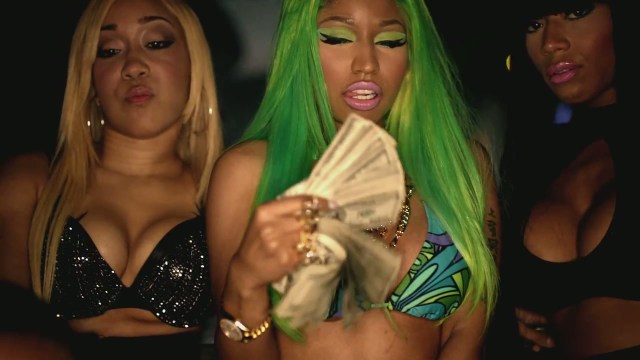
I know y’all knew this was coming. I mean, remember when Nicki Minaj taught us everything we needed to know about female sexuality and empowerment and also gave us a reason to listen to that great song about loving big butts and not being able to lie about? And remember when she released “The Pinkprint,” an introspective and multifaceted album that melts genres and also your heart? I will never forget. I will always remember. 2014 is the year Nicki Minaj came back bigger, better, and more bootylicious than ever. Let’s hope she gets a Grammy or two to prove it.
Roxane Gay
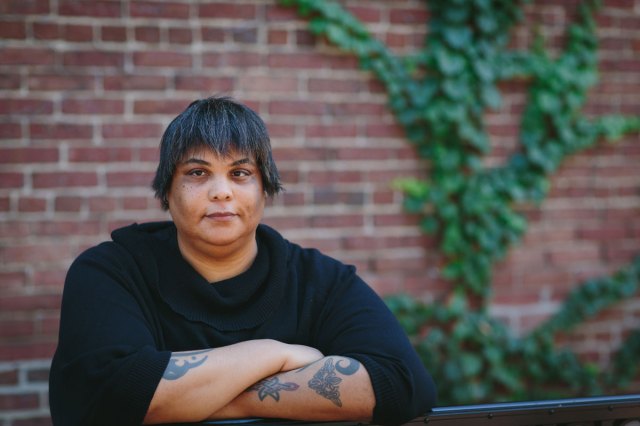
Roxane Gay released two completely delicious and amazing reads this year, told Autostraddle some of her queer story, and became the butter to your toast. What more could we, as the collective world, ask for?
Ruth Bader Ginsburg
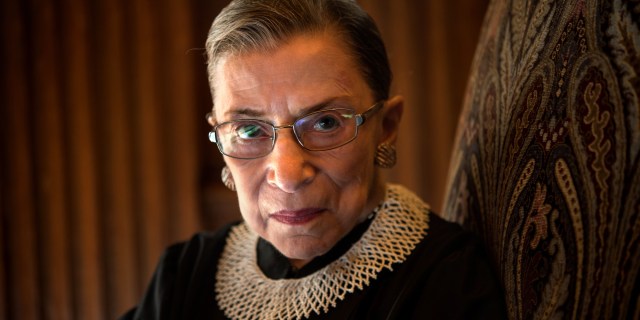
I’m of the opinion that Supreme Court Justice Ruth Bader Ginsburg – known more formally as “The Notorious RBG” – shakes up everything every year. But this year, she took on voter suppression, contraception access, and more, all with her usual flair and also her usual absolute perfection in every way. Then, she announced she was pretty much never throwing in her robe. For that, she wins the year once again.
Shonda Rhimes
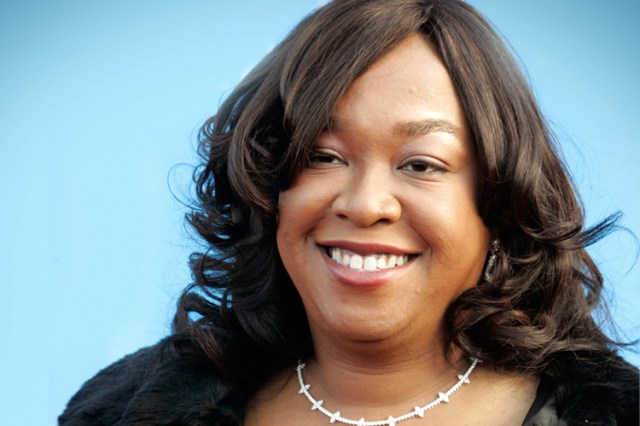
Shonda Rhimes gave us an amazing gift this year with the release of “How to Get Away With Murder,” a totally and unapologetically homosexy drama that pairs well with her first totally amazing drama, “Scandal.” Afterward, she gave us this forever powerful and incomparably on-point series of thoughts on the glass ceiling:
“Do they know I haven’t broken through any glass ceilings,” I asked my publicist. He assures me that I have. I assure him that I have not. I have not broken through any glass ceilings. If I had broken through any glass ceilings, I would know. If I had broken through a glass ceiling, I would have felt some cuts, I would have some bruises, there’d be shards of glass in my hair… If I’d broken the glass ceiling, that would mean I made it through to the other side, where the air is rare. I would feel the wind on my face.
Sleater-Kinney
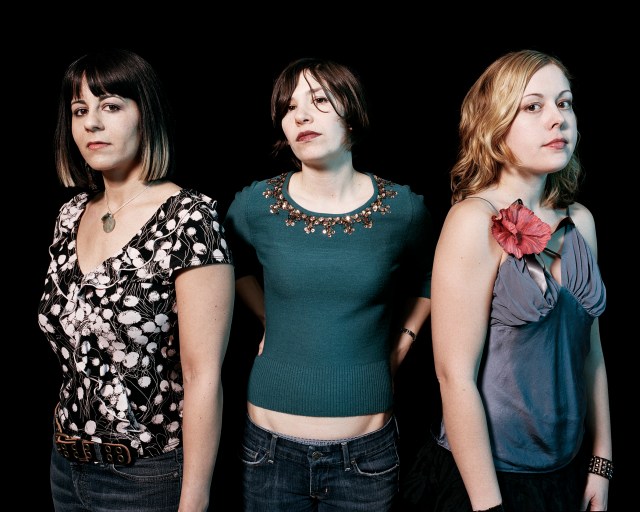
I don’t think I need to explain how a band that probably made a really big impact on your younger, queer riot grrl self reuniting (and it feels so good) made 2014 kick ass. But in case you needed a reminder, THE SLEATER-KINNEY INDEFINITE HIATUS IS OFFICIALLY OVER. Put a bird on that and tweet it, bitches.
St. Vincent
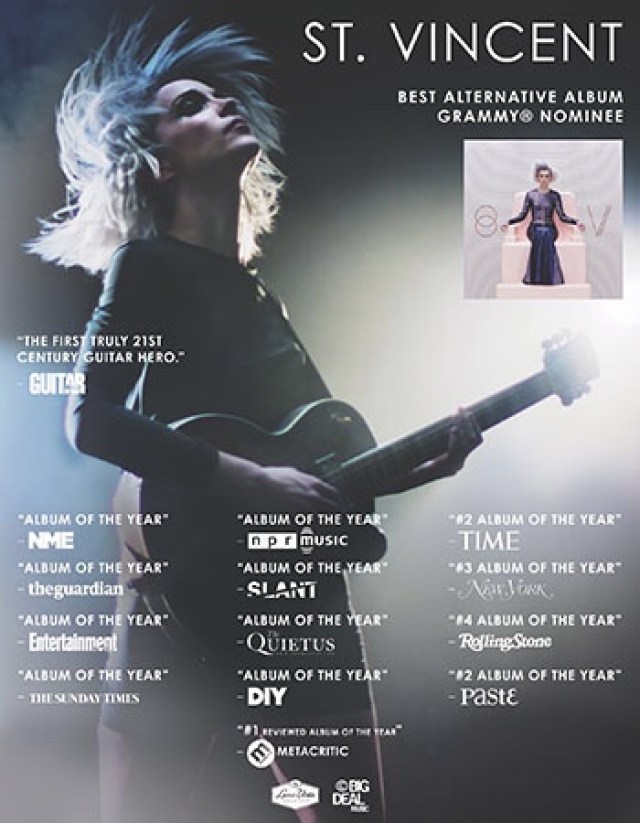
There’s not much more to say here.
Tatyana Fazlalizadeh
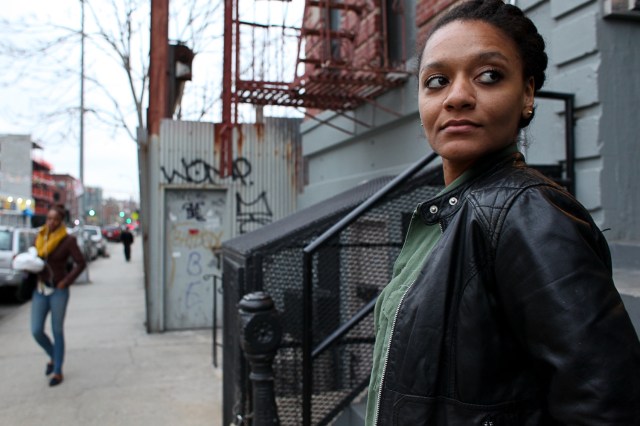
Artist Tatyana Fazlalizadeh’s response to street harassment – posters telling folks to “stop asking women to smile” and reminding them that, like, women are people, too – was perfect from the start late in 2013, but this year it made waves within the feminist community as it spread across the Internet and tattooed itself on our hearts and souls. In the midst of dialogue about women of color and street a harassment, a woman of color stood up and fought street harassment in quite possibly my favorite way ever. For that, I am eternally grateful, and I believe you probably are, too.
Are We There Yet? An Interracial Family Visits a Southern Plantation
The evening I touched down in New Orleans, about to embark on a soul-searching family trip to various sugar plantations, the Darren Wilson decision was reached in Ferguson. I was sitting at a down home barbeque restaurant with my mixed-race sister, Black mother and her white boyfriend of nine years. I mean, we were the friggin’ picture of post-racial prosperity, and yet every one of us was slapped back to reality in one timely Google search. We are avid mealtime Googlers. If we had set the table ourselves it would look something like, from left to right: salad fork, dinner fork, dinner plate, water glass, wine glass, napkin, soup spoon, knife, iPhone. Conversation consists of getting into heated debates that more or less end in Googling the answer; either that, or eavesdropping on the neighboring table and picking up where they left off.
I’ve never been to a protest. Well, I went to one teensy Occupy protest in Amherst while I was at Hampshire, and I did one of those bogus walk-outs in high school so I could drink booze and smoke cigarettes and to feel like part of something cool. But really, as an active participant, no. I’m not proud of this, but I never felt compelled to participate in one — until that night. There was a fury brewing in me that I had never experienced before and I wanted to take to the streets and burn some shit down. Fortunately, I did not have the opportunity to commit arson that night because I was having “family time.” But I’d never felt this before; like somebody was shaking me by the shoulders and saying “you’ve got to do something!” Of course, we were set to embark on a road trip where not only would I have to swallow this rage, but I would be confined to a car, and taking quaint tours of old timey plantations where if I decided to get stir crazy, I would surely be thrown out.
For the next five days we would have circular conversations surrounding the blatant and unending ignorance blinging from our phones via Facebook. As we rolled by the sugar cane fields on the road to Natchez, hugging the border of the Mississippi River, one of us would periodically look up from our screen to announce yet another mind-melting post from some distant white “friend” who felt the need to comment on one of our posts.
“You guys,” my mother groaned, “You will not believe what Christen White just said to me.”
“Her name is Christen White? Oh God, what did she say?”
“This woman… god help her… had the nerve to tell me this has something — anything — to do with Black-on-Black violence. Oh oh oh oh, here’s a quote: ‘nine times out of ten, it’s black men who are killing each other.'”
“Where the fuck did she get that statistic? Oh, Mom, you have to ask her where she heard that. No wait, I got it, I got it. I’m gonna tell her.”
Normally, I don’t make a habit of getting into arguments with people on the Internet, but when people who are normally ideologically aligned with me decide to make their ignorance and thinly veiled paternalism known without invitation, I just… erghhhh. This, of course, goes against what I believe in: that people’s minds can only be changed when you coddle them through it. But goddamn was this particular person irritating. My mother’s boyfriend remained relatively stoic throughout the ride. He really enjoys trees, and the trees along the Mississippi are quite haunting and majestic at the same time.
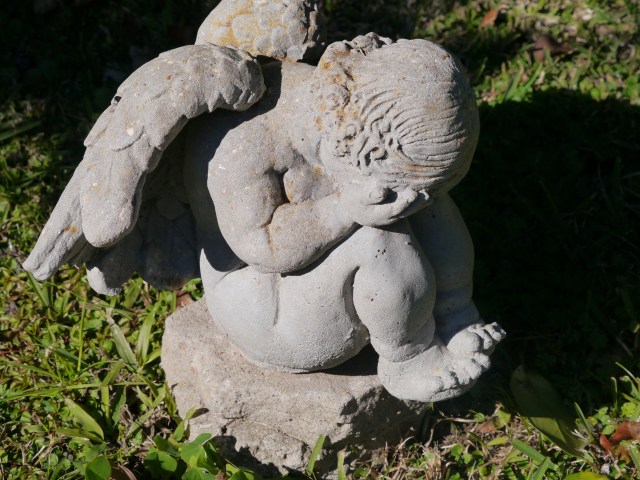
Photo by Keris Salmon
We were able to take a break from our seething and Instagramming when we arrived at Evergreen Plantation in Edgard, Louisiana. An active sugar plantation to this day, our tour guide walked us beneath canopies of 200-year-old oaks with low-hanging Spanish moss that resembled antique lace. We were walked through the “big house”— incidentally the same exterior used to film some scenes in Django Unchained. Particularly, one of my favorite scenes (I know) in which a slave woman asks of her master, “You want us to treat him [Django] like white folks?” I don’t know, that one just had me rolling — but I digress.
Burnt orange rooms with hardwood floors led us to marble hallways accented with wicker furniture sporting palm-patterned pillows. The rooms were tastefully designed with Victorian and Edwardian antiques that were perfectly preserved. We were told that our tour guide does not know the cost of upkeep on the meticulously kempt grounds because whatever it is it doesn’t matter: “The owners are oil heirs. This is just a hobby.” Quite a hobby.
We were walked to the slave quarters, some still standing, others restored. They were basic shacks, between three and five to a room. Although tiny, they were bigger than I thought they would be. We were told of the French colonial slave-keeping laws, which were apparently more humane than those of American, British or Spanish colonial laws. When we were told that the slaves were encouraged to be married, that young girls must be sold along with their mothers and kept from work until the age of fourteen, and eventually buried alongside their masters in the Catholic cemetery, we caught ourselves doing that raised-eyebrow, pompous nod of surprise until we were able to remind each other that these people, however less oppressed than their neighbors, were still fucking slaves. It seems that even back then, darker skinned folks were being handed a bone and told to be grateful for what they had.
When we arrived at the Dunleith Plantation in Natchez, Mississippi, it was almost dinnertime. We got properly soused on red wine, ate some food (I can’t recall what) and I fell face-first into my pillow, expecting to wake to a sprawling historical plantation much like Evergreen. One of the first things my mother’s boyfriend noticed upon waking up Thanksgiving Day, was that all of the rooms were named after prominent confederate soldiers. This information he bestowed upon us with didactic self-confidence. I was totally freaked, but he seemed more intrigued than horrified. How apropos that we spend Thanksgiving, arguably the most colonial holiday next to Columbus Day, in the most colonial environment in America. I couldn’t help but think that if indeed this particular plantation had any affiliation with actual confederate soldiers, that was creepy because the ghost of Stonewall Jackson was probably staking out my bedroom door with a sawed-off shotgun while I slept. And, if in fact, this plantation had nothing to do with the confederacy at all, then what the hell were the bed-and-breakfast owners doing naming the rooms in honor of the most racist blight on American history? I wanted to get out of there fast, but we were slated to enjoy Thanksgiving dinner on yet another nearby plantation and nothing was open at the moment so my only hope at eating anything that day was to wait it out, hangry as hell, refreshing my stupid Facebook feed until dinnertime. For the record, it turns out that neither of these places were actually plantations, but plantation-style homes. Nonetheless, they almost certainly employed a cadre of slaves, so the details don’t exactly sway me.
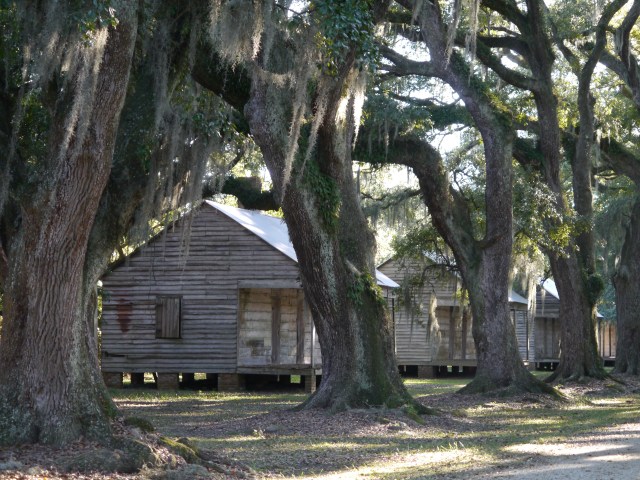
Photo by Keris Salmon
The next morning, as my mother and her boyfriend ate their breakfast, they approached a couple that had been sitting next to us at dinner the night before. They looked nice enough: older, white, kind of edgy looking. The dude had a kind of Keith Richards thing going on. My mom asked how their dinner was. They said it was fine, and remarked how we were being kind of “rowdy,” most likely referring to our umpteenth heated discussion of the events in Ferguson. And then he asked my Black mother and her white boyfriend, “so… uh, how in the world did you two get hooked up???” My mother, bless her heart, tried with every cell in her brain to rationalize this question. She thought, “maybe he thought I was wearing whacky clothes, and Frank dresses so conservatively.” She does dress very colorfully (pun not intended). But the rest of us took it for what it was, even Frank. And after so many days of suppressed mania, a wave of exhaustion washed over me. The nail in the coffin was when I called my 98-year-old grandmother from the car on our way back to New Orleans. She said, “I just… cannot believe y’all are in Mississippi. Although, I guess times have changed a bit.” Yeah, grandma. A bit.
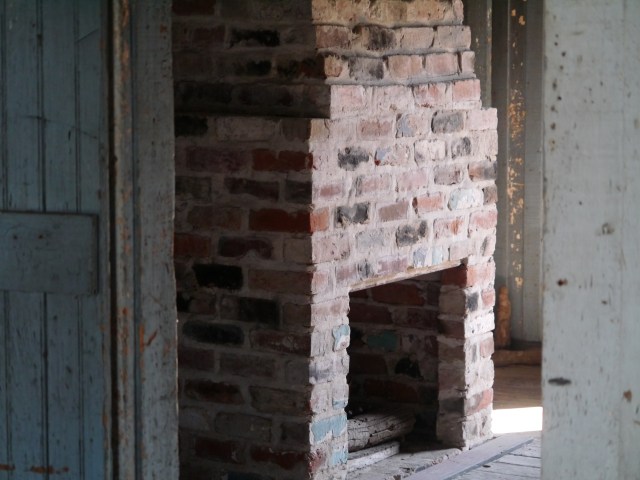
Photo by Keris Salmon
Two days after returning to New York, the cop who murdered Eric Garner was absolved of any indictment. But instead of rage, or anxiety, I felt tired. Tired from travel, perhaps, but also just wiped. Worn down by the concurrent weight of history unraveling behind me and the present unfolding before me, I felt paralyzed. History is repeating itself too soon, it seems. It’s déjà vu all over again, and the only tools we have to address it are our voices. That weekend, I was in the streets, but not to rage or burn. I was there to mourn, or rather, to wait. Because at this stage of grief, my only burning and desperate question is: Are we there yet?
Audre Lorde Project Hosts Vigil and Flashmob To “Free Our Sisters, Free Ourselves”
On Monday evening, approximately 200 people gathered in Washington Square Park for “Free Our Sisters, Free Ourselves,” a gathering to honor Black women and trans and gender non-conforming people who have been murdered by the police. As part of the 11 Days of Action called for by #ThisStopsToday, Free Our Sisters was held in solidarity with other protests against the Staten Island grand jury’s failure to indict officers in the killing of Eric Garner. Hosted by the Audre Lorde Project and several allied organizations (FIERCE, Streetwise and Safe, Sylvia Rivera Law Project, and Anti Violence Project), the event began with a large vigil and concluded with a tour of prominent sites of violence and resistance in the queer and trans struggle for prison abolition and police accountability.
In contrast with the vast and thundering NYC Millions March that originated from the same location just two days prior, Free Our Sisters was a reserved, community affair. At the start of the vigil, organizers gathered participants into a large circle, singing “we found love in a hopeless place.” Organizers discussed how that they had specifically chosen not to hold a march — rather, they wanted to give voice to resistance without risking members of the community being arrested, acknowledging that many in the space had survived violence.
This is what community looks like #FreeOurSisters #ThisStopsToday #11Days #LGBTQ pic.twitter.com/SAIiADDUJl
— AVP (@antiviolence) December 16, 2014
“To be clear, we are not here to change the system. We are here to shut it down,” said Audre Lorde Project member Simone. “Audre Lorde reminds us that the master’s tools will never dismantle the master’s house. And in this moment, this struggle is not about bad cops. This struggle is about all cops. This is about transforming the system of oppression that created and sustained the prison-industrial complex. Let’s not forget that police forces were originally built to control and murder indigenous and Black people in this country… We’re socialized to turn to social workers and police when things happen, but we have resilience and resistance, strategies that have always worked for us. Let us rely on each other.”
Supportive cheers resounded.
“In the words of Audre Lorde, ‘we must fight knowing we were never meant to survive,” said Cara Page, Executive Director of the Audre Lorde Project. “We call upon the legacy of the Stonewall uprising. We call upon the legacy in the fight for our freedoms from the racist, homophobic, transphobic, classist, ableist, violent system. Tonight we will call out the names of some, not all — the ones that we know have been killed at the hands of the police, or from their neglect in upholding our safety. We cannot name all the names because often we are disappeared and not remembered.”
#FreeOurSisters! Here in Washington Square Park with @audrelorde. #TransLivesMatter #BlackLivesMatter pic.twitter.com/mOH2fzoqDq
— Naimah Hakim (@NaimahHakim) December 15, 2014
In tribute, Anti-Violence Project Community Organizer LaLa Zannell stood before the group and called out the names of victims of police brutality, including Yvette Smith, Eleanor Bumpurs, Aiyana Stanley-Jones, Tarika Wilson, Islan Nettles, Marlene Carey, Marsha P. Johnson, Latanya Haggerty, Margaret Mitchell, and Aura Rosser. Members of the crowd responded with “presente” and chimed in with additional names.
Following this, the group split into four sections where they received instructions to disperse, travel separately, and meet up flash-mob style in four locations around Greenwich Village: Stonewall Inn, the former Women’s House of Detention, the ICP Center, and outside of the old Barnes and Noble on the corner of 6th Ave and 8th Street. Once reassembled, participants were given a quick history lesson on the location’s relevance to the movement.
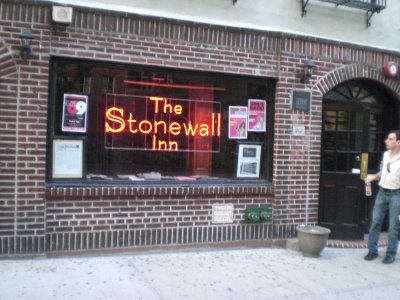
The Stonewall Inn.
In 1969, the Stonewall Inn became the site of one of the most important protests in LGBT American history. On June 28 and 29, crowds fought against the then-common police raids of the bar. Although this fact is frequently erased, the Stonewall riots were led by trans women of color.
Today, Black queer women are still frequently uncredited, even as they lead some of the most high profile social justice actions around the country. This includes Alicia Garza, Patrisse Cullors, and Opal Tometi, the creators of #BlackLivesMatter.
Magically, a crowd appears @ former women's house of detention following footsteps of #stonewall warriors vs #NYPD pic.twitter.com/qpLx5kscL1
— Andrea Ritchie also @dreanyc123.bsky.social (@dreanyc123) December 16, 2014
From 1932 to 1971, the Women’s House of Detention was located in Greenwich Village. Many women were held here, including Angela Davis, who was incarcerated as a political prisoner for 18 months. (Later, she was cleared of all charges.) While inside the prison, Davis mobilized prisoners and initiated a bail program. When she left, Davis co-founded Critical Resistance, a grassroots prison abolition organization that popularized the term “prison-industrial complex.”
Chanting in front of IFC center ! pic.twitter.com/XlrdEqqRb5
— Audre Lorde Project (@audrelorde) December 16, 2014
In 2006, seven Black lesbians were arrested for defending themselves outside the IFC Center movie theater. After 19-year-old Patreese Johnson turned down several raunchy advances by Dwayne Buckle, he called her anti-lesbian slurs and jumped on another member of the group, Renata Hill. The friends stepped in and successfully defended her.
Although the attacker never received any punishment within the criminal justice system, the women themselves were painted as “gang members” and criminalized. Three of the women entered into plea agreements and received six-months in prison. The remaining four received initial sentences ranging from three and a half to 11 years in prison.
https://twitter.com/simongdunham/status/544646478703390721
Last May, Mark Carson, a black gay man, was murdered at the corner of 6th Ave and 8th street for simply walking on the street with another man. The killer, Elliot Morales, heckled the pair with anti-gay slurs, pulled out a gun and shot Carson to death.
To many, Carson’s death was particularly shocking because it had taken place in the middle of gay-friendly Greenwich Village. It brought to light a grim truth: for people who are both LGBT and Black, there are very few places of sanctuary.
For more, check out the Audre Lorde Project’s live tweets from the event at @audrelorde. They are also putting together a short documentary film.
Dispatches From The Millions Marches: Thousands Show Up For #BlackLivesMatter Nationwide
This past weekend, tens of thousands of protesters participated in massive demonstrations all over the country to protest police brutality, an unjust legal system and systemic racism as made blatantly clear by the recent murders of Michael Brown, Eric Garner and Tamir Rice by police officers. About 30,000 people gathered at Washington Square Park in New York and marched to NYPD headquarters as part of Millions March NYC (organized by Synead Nichols and Umaara Elliott). In Washington D.C., tens of thousands of people showed up for the “Justice for All” march organized by Rev. Al Sharpton’s National Action Network. Protestors marched from Freedom Plaza along Pennsylvania Avenue to the National Mall where family members of Michael Brown, Eric Garner, Tamir Rice and Trayvon Martin spoke. In the Bay Area, thousands marched from Frank Ogawa Plaza to the Alameda County Courthouse. In Chicago, several hundred protesters gathered.
What follows is aggregated news reports and original reports from cities where we had reporters on the ground.
New York City
Tens of thousands protestors gathered at Washington Square Park and marched about four miles to NYPD headquarters to protest demand justice for victims for police violence. At the helm of the procession, the family members of Ramarley Graham and Kimani Gray carried a “Black Lives Matter” banner. Organizers of Millions March NYC called Dec. 13th a “Day of Anger” and hoped that “millions of people will go peacefully into the streets all over the country to disrupt business as usual, express their anger, and demand justice for victims of police violence and institutionalized racism.” They did just that.
QTPOC Speakeasy member Elisa Peebles, an organizer and activist, attended the NYC Millions March with her mother.
“While it is definitely tragic we still have to march, there is something beautiful and hopeful about the fact that I am fighting for [my mom’s] freedom as much as mine, and we’re both out here so that my nephew, who just turned one, hopefully won’t have to march when he grows up,” Peebles said. “This moment transgresses time and in that sense this movement is beyond the individual; it’s truly for the whole collective.”
Peebles also marched with her “gaggle of diverse queer comrades, most of whom I traveled to Ferguson with and have been organizing around, talking, thinking, and crying about this movement with.”
“I realized today that through this work we have all grown together and grown closer together, which is such a privilege to have,” Peebles said. “As a QPOC and woman, it is really hard to find a comfortable and supportive space to do this work. I urge everyone to take this moment as an opportunity to either find their people or BUILD A QUEER/QPOC space within which they can mobilize and tackle the work of this movement. It will save your heart.”
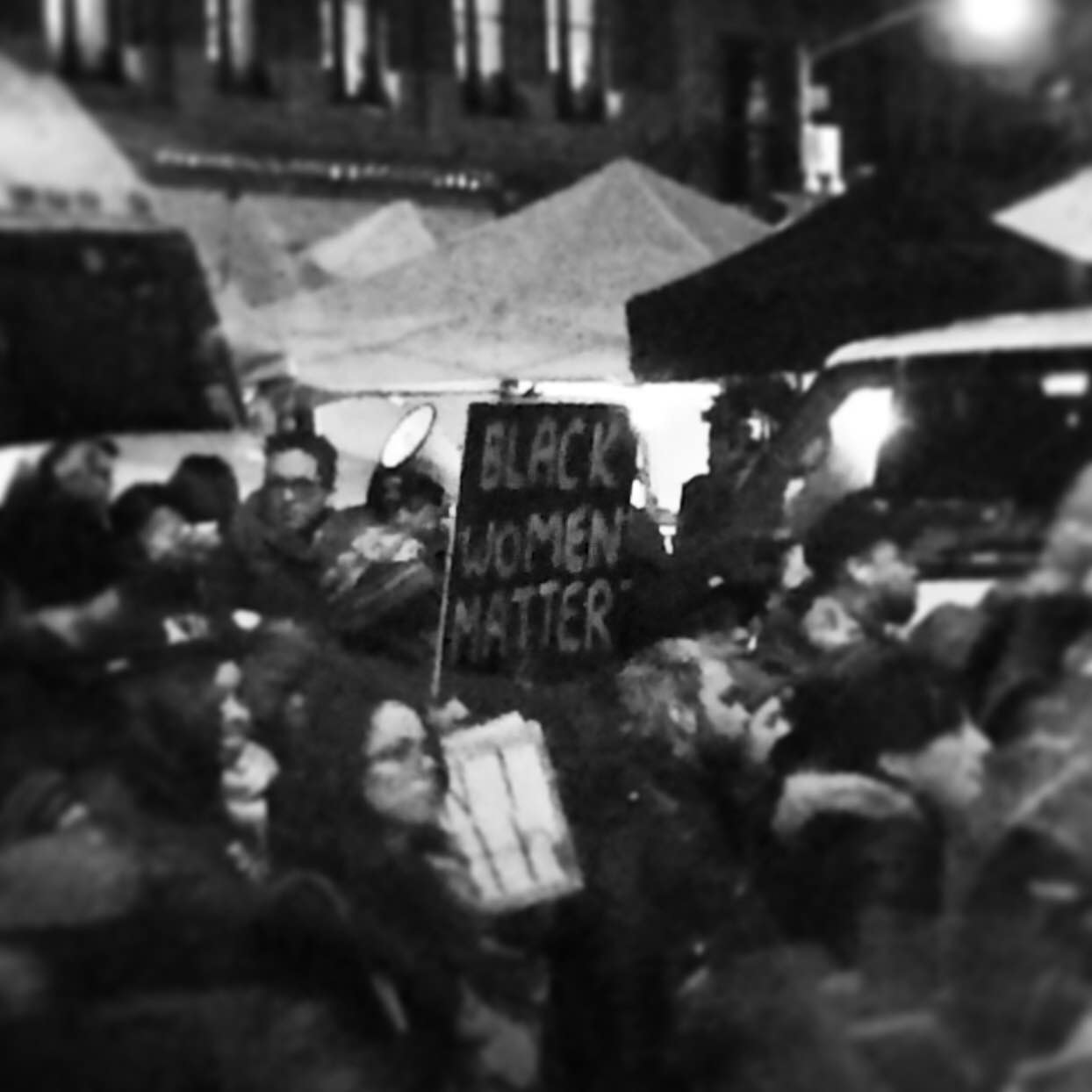
By Elisa Peebles
Peebles said the last sign she saw at the NYC Millions March said “Black Women Matter.”
“I feel that now as we are finally getting to a point nationally and internationally of recognizing the significance of the #BlackLivesMatter movement we can now start highlighting and stressing that the majority of the people behind it, leading it and sustaining it since day one are Black women, including the people who came up with the hashtag [specifically: Alicia Garza, Patrisse Cullors and Opal Tometi]. From Ferguson to NYC, I have witnessed Black women at the front lines, willing and ready to make whatever sacrifices necessary (including that of their own lives) for this movement, one that unfortunately is focused mostly on the Black men who have been killed by police and not so much the women. Despite the question of whether or not we’d still be in the streets for a Black female victim, these women don’t falter in their dedication. I hope that we can work harder to elevate this point, even if it’s just amongst our own community.”
Our contributing editor Laura Mandanas also attended the protests and took photos:
- NYC Millions March. “Hands up. Don’t shoot.” By Laura Mandanas
- “Hey hey. Ho ho. These racist cops have got to go.” NYC Millions March. By Laura Mandanas
- “What do we want?” “Justice.” “When do we want it?” “NOW.” NYC Millions March. By Laura Mandanas
- “The entire system is guilty as hell. Indict. Convict. Send those killer cops to jail.” NYC Millions March. By Laura Mandanas
- “Eric Garner. Michael Brown. Shut it down. Shut it down.” NYC Millions March. By Laura Mandanas
- ‘How do you spell racist?” “U S A” By Laura Mandanas
- “Black lives matter.” Millions March NYC. By Laura Mandanas
- We finally got to City Hall. By Laura Mandanas
- Main stage speaker area at City Hall. By Laura Mandanas
Washington, D.C.
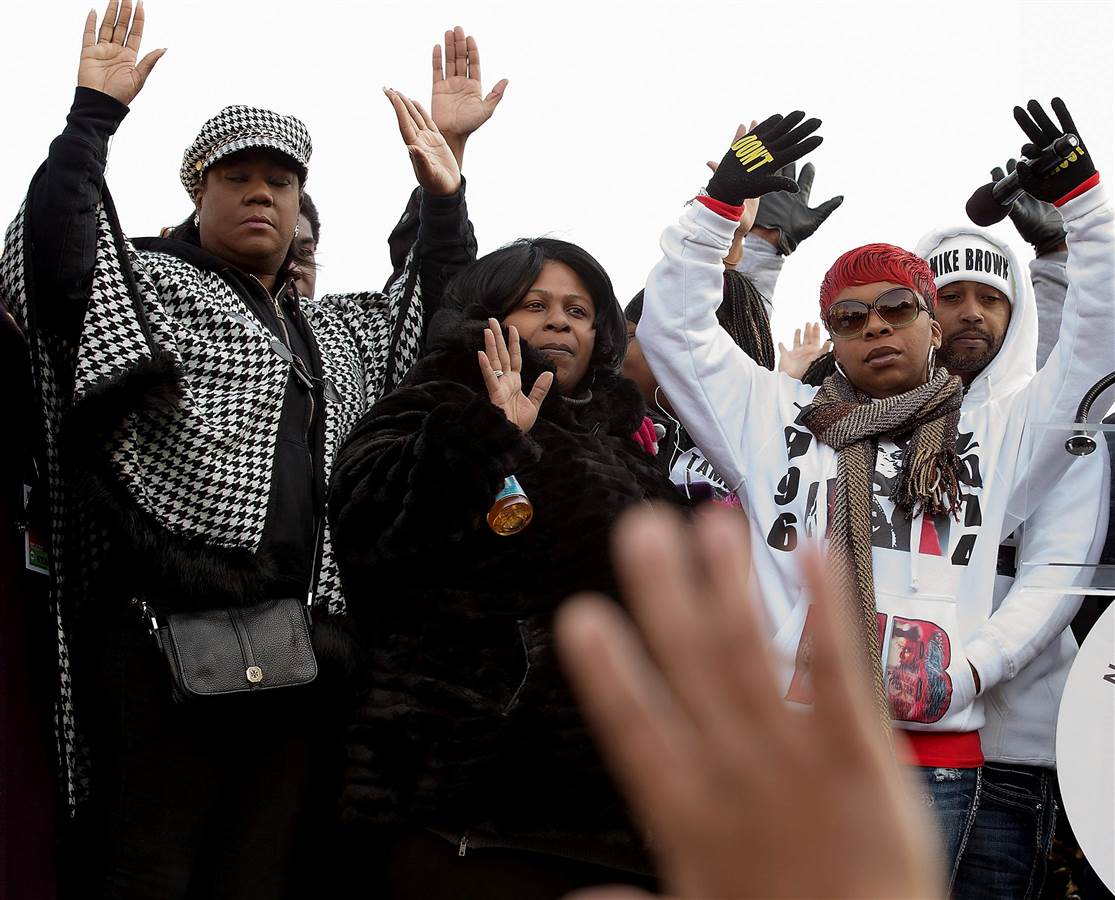
Kadiatou Diallo, mother of Amadou Diallo; Sybrina Fulton, the mother of Trayvon Martin; Samaira Rice, the mother of Tamir Rice; and Lesley McSpadden, the mother of Michael Brown Jr. at the Justice for All march. (By Chip Somodevilla / Getty Images)
Thousands marched in D.C. with the families of police violence victims, including relatives of Michael Brown, Eric Garner, Tamir Rice, Akai Gurley and John Crawford, leading the march. The mothers of black men killed by police spoke at the rally including: Samara Rice, Tamir Rice’s mom; Sybrina Fulton, Trayvon Martin’s mom; Gwen Carr, Eric Garner’s mom; and Lesley McSpadden, Michael Brown’s mom and Kadiatou Diallo, Amadou Diallo’s mom. They thanked the protestors around the nation for showing up and making their voices heard and to keep fighting for justice.
“It is almost like you don’t need to say any words, you can just look out and see all of the people,” Lesley McSpadden told the protestors. “They shot our sons, but they did not die.”
Al Sharpton called for Congress to take action on police brutality at the rally. “We are not anti-police; we are anti-police-brutality,” Sharpton told protesters. “And today we challenge Congress to follow in the president’s footsteps and take legislative action to protect us, the citizens.”
Sharpton and the Justice for All March faced criticism from young activists and organizers in the days leading up to the march. The critic’s main concerns were that the march was clearly steering clear from looking like the revolutionary movement that began in Ferguson after Michael Brown was killed by police, while also benefitting from the attention.
Like The Root pointed out, these criticisms were proved to be true when a few young activists from Ferguson powered onto the stage after NAN officials denied them access. Apparently there was a VIP section and only those with passes were allowed on stage. You can see what went down in the video below.
Chicago
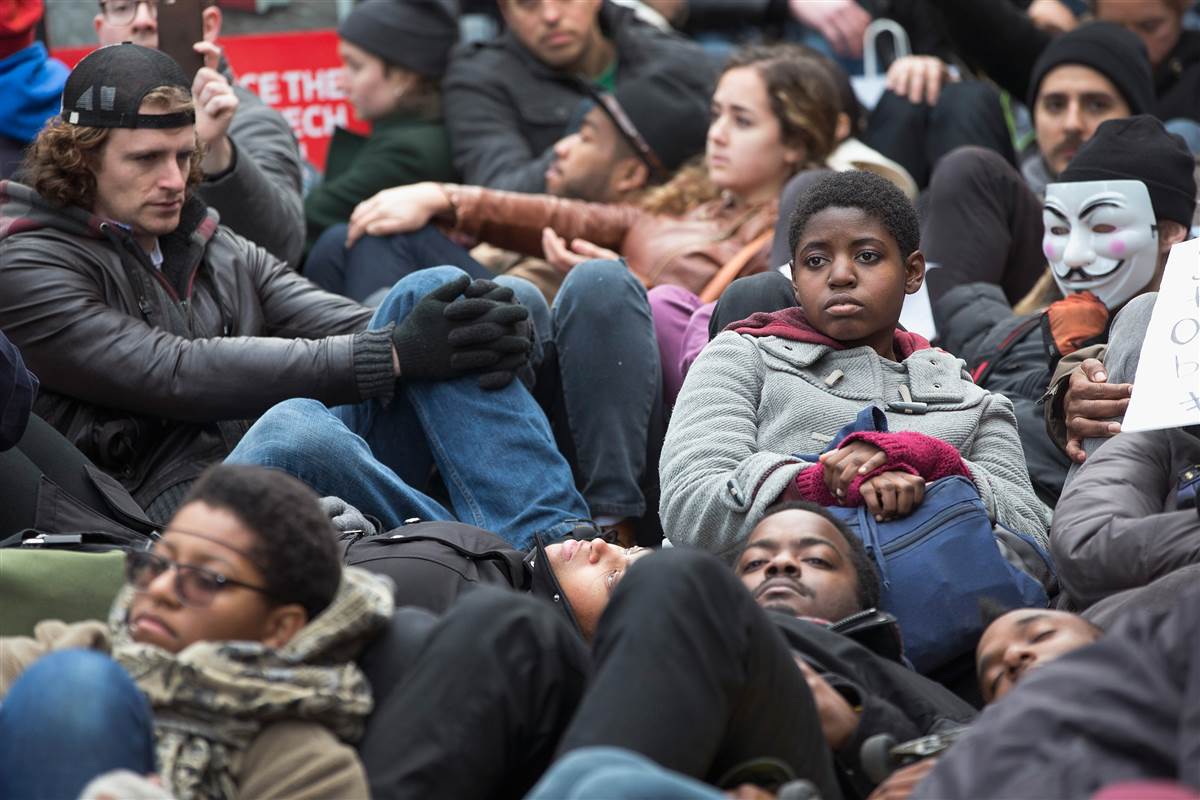
By Scott Olson / Getty Images
In Chicago, a couple hundred protestors gathered downtown in solidarity with the marches in NYC and Washington, D.C. They held a die-in along the Magnificent Mile, the city’s famous shopping area. The die-in shut down a portion of the sidewalk on the corner of Michigan Avenue and Chestnut, amidst a busy shopping day. Several protestors were arrested when they attempted to demonstrate inside of the Magnificent Mile’s Nordstrom store but police stopped them before they could make it inside. The march continued and ended at the Water Tower building where several people spoke.
Berkeley and Oakland
by Riese

It had been a tumultuous few weeks leading up to Saturday’s march — a week prior, about 100 or so protesters in Berkeley (including me) had been tear gassed by police officers, unprompted by any violence or aggression from protesters. The officers had declared the gathering an “unlawful protest” and the tear gas was their way of clearing the streets, I guess. The only unruly activities happening were a few white male anarchists who kept knocking shit over and rolling tires into the street and yelling at and mocking anybody who questioned their methods or cleaned up their mess — including black people. On Sunday night I’d see a white male anarchist in a struggle with a young black man who was trying to stop the white anarchist from knocking over yet another trash can. I wasn’t surprised when one of those white men was outed as an undercover cop — at which point he pulled a gun on protesters. There is definitely a divide within the movement regarding whether or not vandalism and violence is a useful response and I’m not here to judge any PoC who advocate for it — regardless, the majority of protesters have been peaceful, despite what the news has been reporting. For white people the choice should be easy: don’t start shit without the go-ahead, leadership, invitation or support of black folks. Follow their lead and listen up.
Protests continued all week in Berkeley and Oakland. Highways were blocked off, demands were made, streets were marched on, support was gathered, a city council meeting was cancelled, BART stations got closed, stores were damaged, hundreds of people were arrested, high school students walked out of class, streets were taken over and we got used to hearing helicopters every night starting at 4pm. This movement was moving, and momentum was building in an unprecedented speed. The city, meanwhile, continued doing absolutely everything wrong.
For Saturday’s March, which was put together by community organizers including the Black OUT Collective, NoBusinessAsUsual (the organizers of Black Brunch) and UC-Berkeley’s Black Student Union, showed UP. Big time. Thousands of protesters came out for this.
The Oakland March congregated in Oscar Grant Plaza in downtown Oakland, where the main organizer went over some crucial rules for white allies — give the megaphone to a black person, if you’re interviewed by the news, direct them towards a black person. Make room for black people. Do not say “we can’t breathe,” do not say “all lives matter.” She then called all black folks to the front of the crowd. We listened to a few brief speeches — all of them galvanizing and fantastic and all of them from black women or women of color.
Then we marched to the Alameda County Superior Court, black people leading the crowd. The Berkeley group — reeling from that morning’s revelation that effigies had been hung throughout UC-Berkeley’s campus, which turned out to be a poorly-received action organized by a queer and POC artist collective — met the Oakland group at the courthouse. The crowd was inspirational and enormous and diverse — so many children, so many senior citizens, so many families. (Also, SO MANY LESBIANS.) All of the scheduled speakers again were black women, including Oscar Grant’s mother, Wanda Johnson. She told the crowd, “We want officers held accountable. We want officers to be able to feel the pain just as we feel it. We got to stand up to the police brutality in our nation.”
March organizers spoke about the importance of organization and seizing this moment to finally make a change. Any folks of color who had lost a loved one to state-sanctioned police violence was asked to come forward and speak, including a young man whose cousin, Amadou Diallo, had been shot 42 times by police in 1999 and killed. From where I was standing I couldn’t see the speakers and often necessary words were drowned out by the helicopters circling the sky, but the crowd was attentive and strong.
As a white person my takeaway from the event is that some really incredible groups of black activists are working on organizing a massive and transformative racial justice movement, often in solidarity with other people of color. So we (white people) will be there when they need us, step back when they don’t, and should do everything we can within our own communities to educate and inspire more activism.
After the march, some protesters continued protesting and others went to Oscar Grant Plaza for the Healing Stations and Legal Aide Stations set up for black folks by the march organizers.
I welcome corrections and additions in the comments as well as submissions or any testimonies from PoC who attended the Bay Area marches.





